ODD AND INTERESTING THINGS THAT
DON'T FIT ON MY OTHER PAGES.
Page Started:
12/23/2010 Last
update: 12/12/2024
Text
and images on this page ©2005-2024 Richard
Dashnau
Go to Welcome
to Rickubis.com for links to my other pages.
Go
back to my RICKUBISCAM page
This is the page where I will put pictures
and videos of unusual things or things that don't fit on any of my
other pages.
08/20/2024
I
wanted to try my second prototype pole for
getting higher-altitude video without using a
drone. I'm at Fiorenza Park North, on the East
side of
the mound at the Hillside Trail.
In the first image below, the water tower in
the background is East. In the second
image below, I've turned the camera to face
West, so I'm looking
at the top of the hillside and the horizon to
the West. Rules for flying drones in parks are
complicated; and, I don't have one. So this
long pole is just an experiment. The camera
is an old GoPro Hero 3, and I used the GoPro
software to remove the "fisheye" effect from
the video.
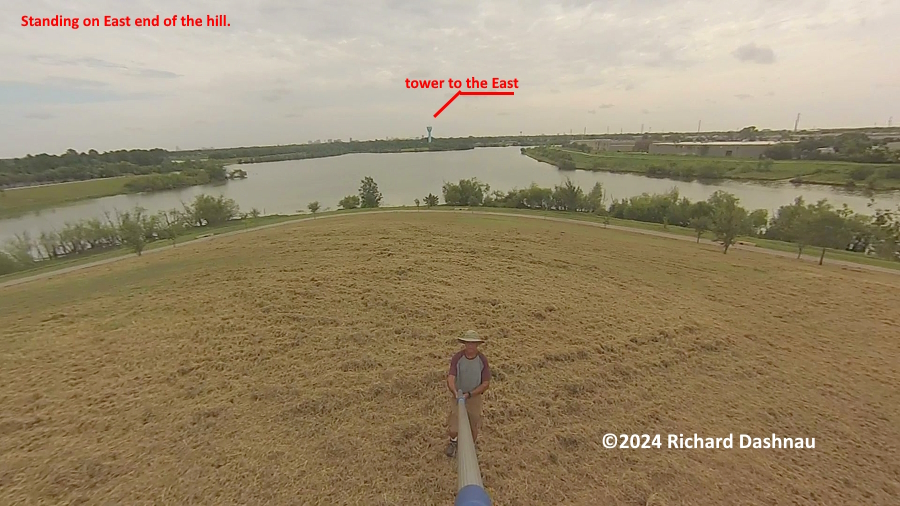
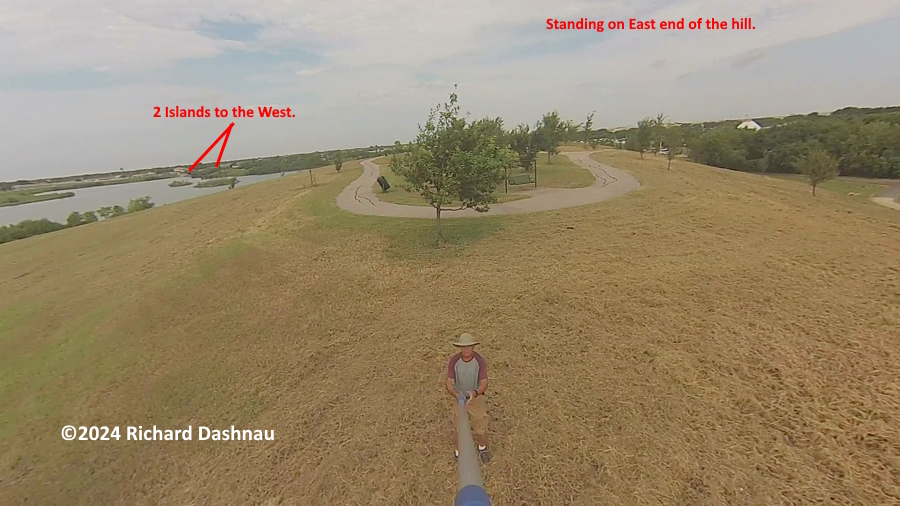
Then I moved to the West end of the mound.
This pole is 16 ft. long, and a lot more
flexible than the other one, so more unstable.
This park is 360 acres. Even these images
don't
show the full size of the "lake" in the park.
In the first image below the camera is
pointing East, we can still see the water
tower to the East, and the spot were I was
standing before
on the far end of the hill. The
second image
below is with
the camera
looking West.
Highway 6 is
at the
furthest edge
of the
water-past the
2 islands.
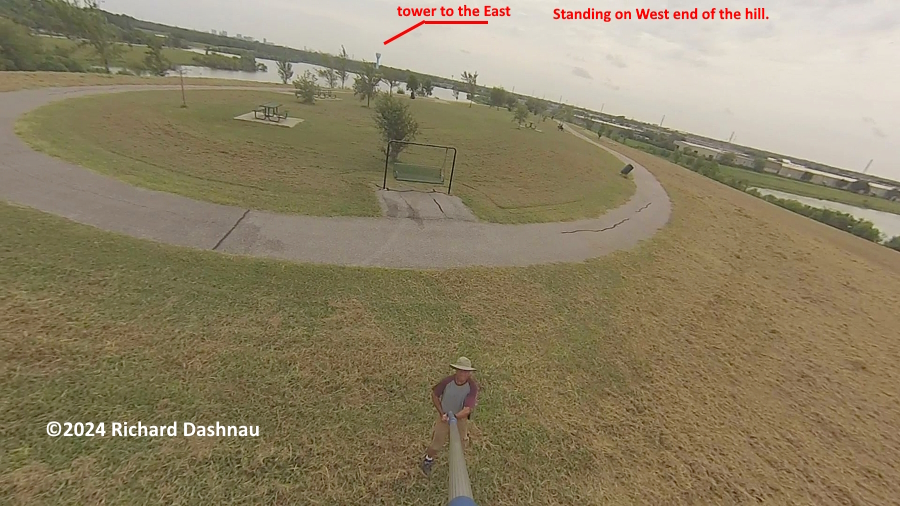
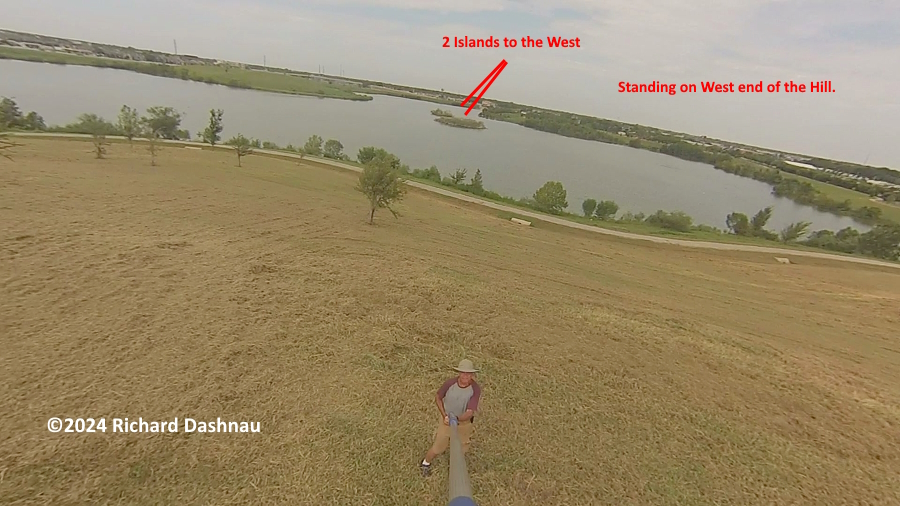
The
images below are from video was taken with my
phone at a different park on the next day
8/21/2024 to demonstrate the size and
deployment of the pole (without a camera on
it). The
segments are locked or unlocked by twisting
them. At full extension with segments locked,
the pole is "floppy" - even without the small
added weight of the GoPro. But the pole is not
too
heavy. And the pole collapses easily. I've
edited the
video from
both clips
into this file.
Note:8/22/2024
I've updated
this document
showing how I
built the
first
prototype
extension arm;
also details
of the
assembly and
test of the
second
prototype.
It's in this
pdf file.
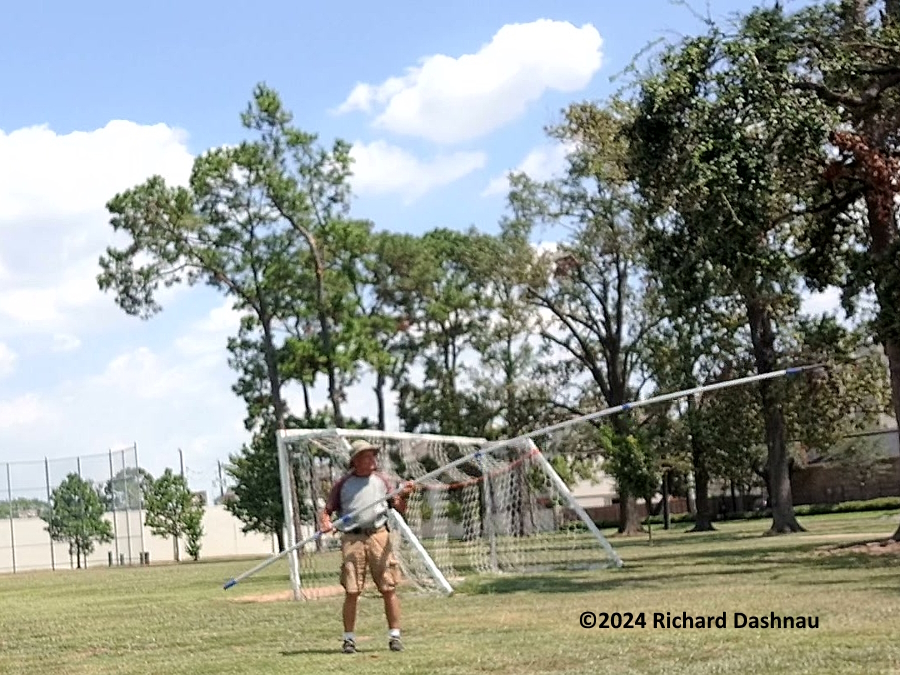
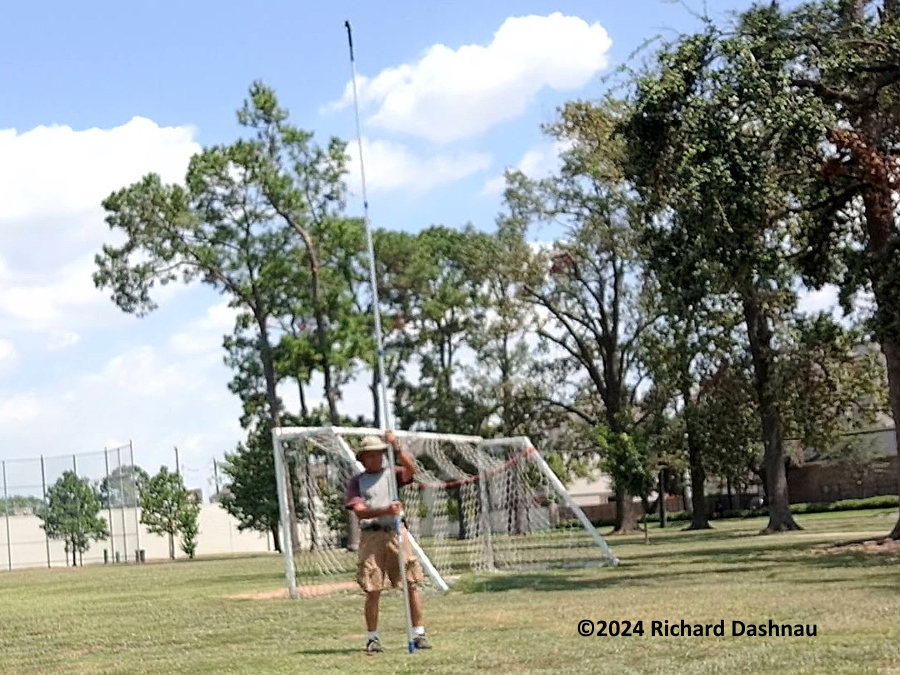
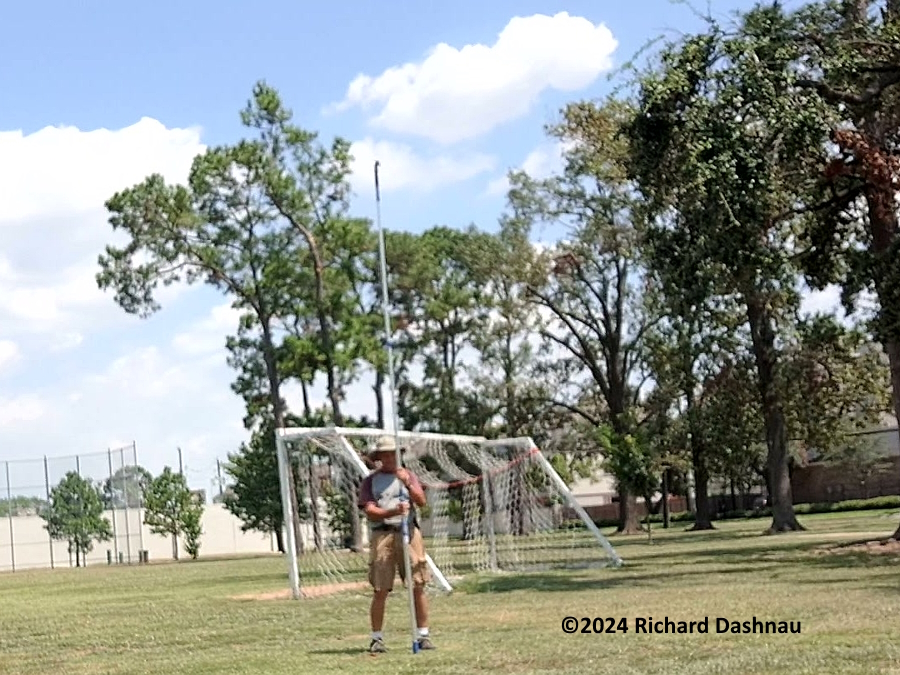
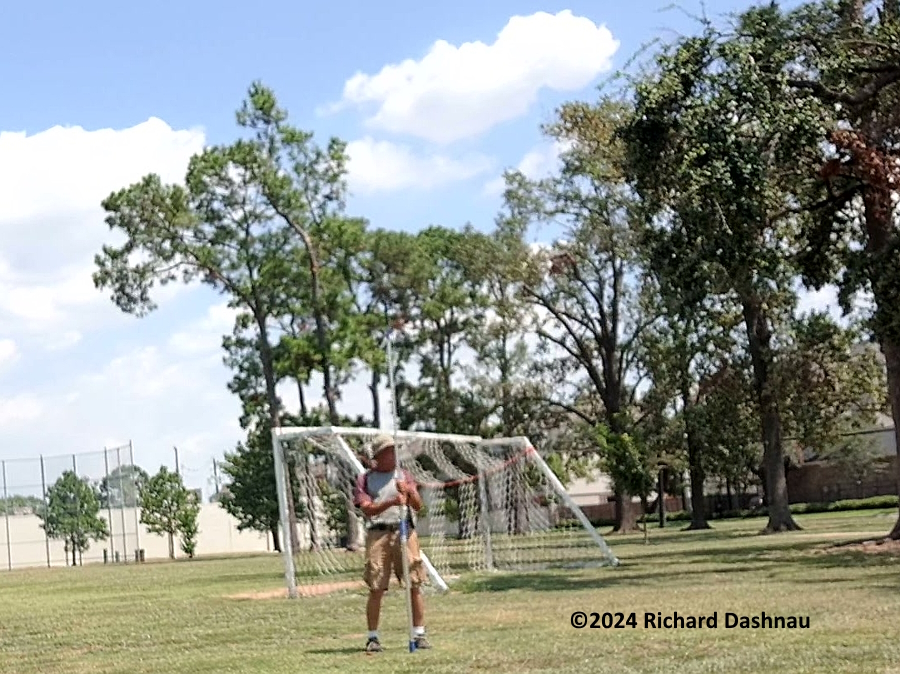
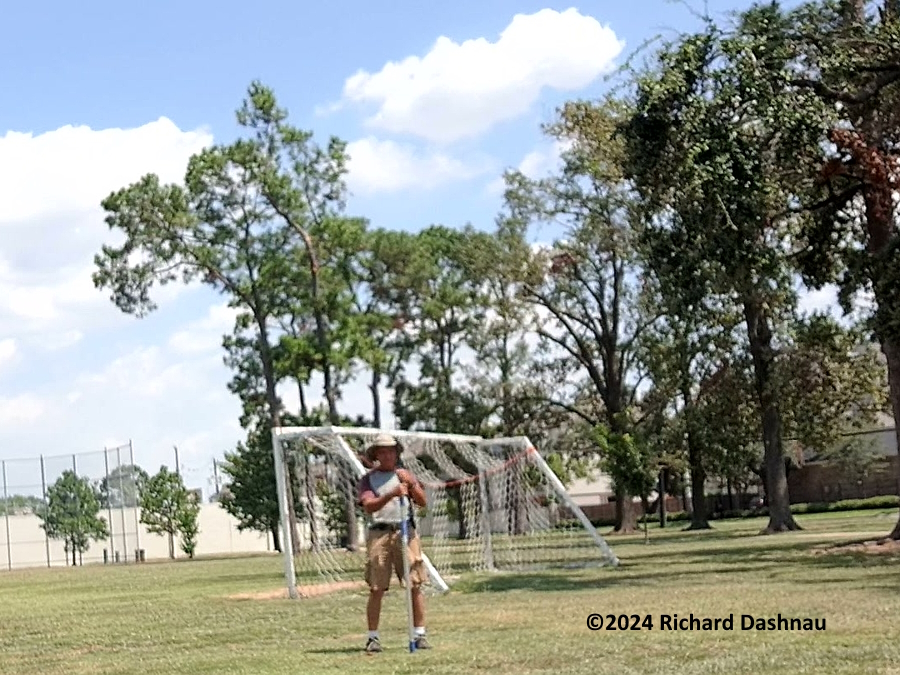
08/11/2024
After
coming out here a couple days ago
to watch Mississippi Kites flying,
I thought it would be nice to show
a better view of the top of the
Kinder Land Bridge. I don't have a
camera drone (and rules regarding
drones are complicated). So
I tried this experiment with a
long pole, and my old GoPro Hero3
camera.
I'm standing on top of the West
hill of the Kinder Land Bridge.
That circular sidewalk surrounds
the West Lawn. The tunnels are
East of me. The circle is West of
me.
My
shoulder's been messed up since
Beryl. So it's held together
with tape on bad days. I
could brace the pole against my
hip for the one-handed shots. Two
tunnels just
like those in the background
pass under where I'm standing.
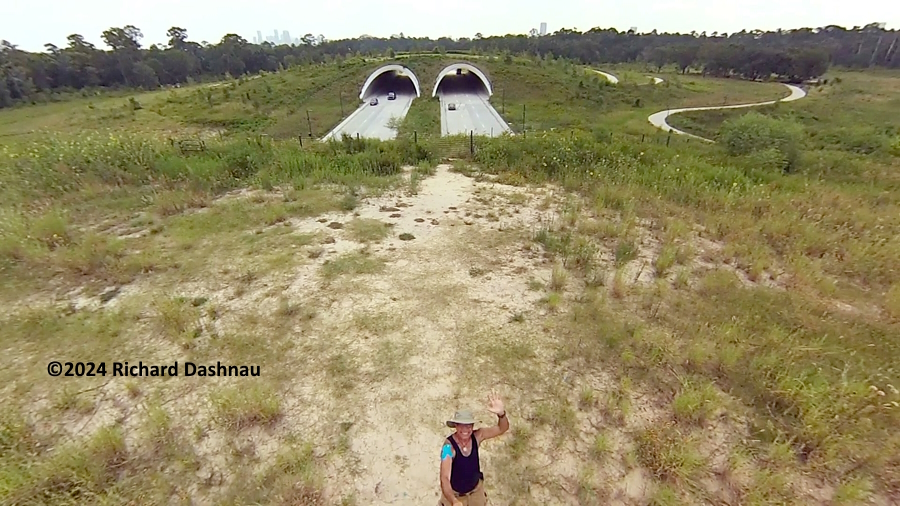
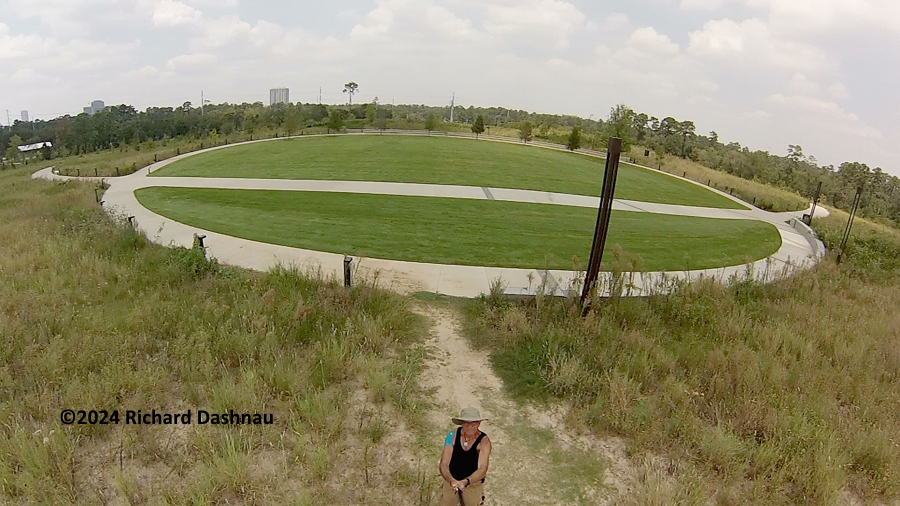
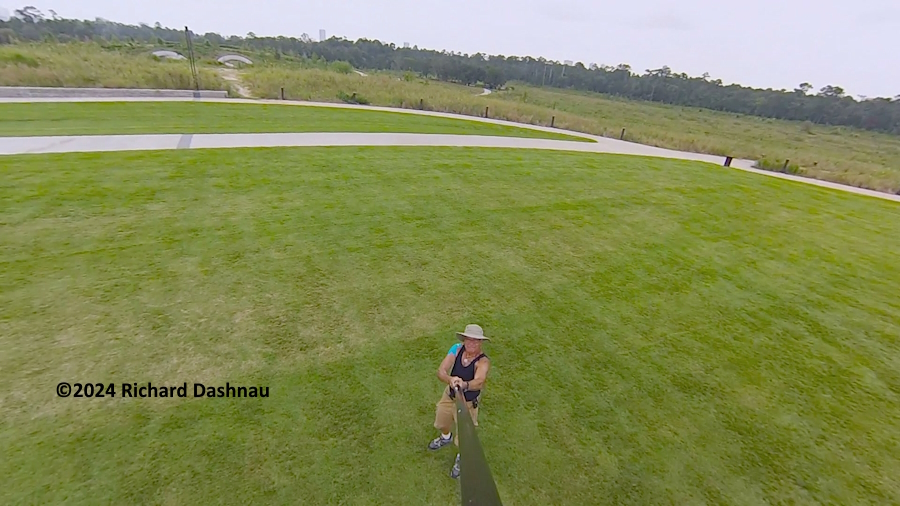
The KInder Land Bridge just
opened in February of
2023. This is the West Lawn
again. I'm using a "duckfoot push
pole" that I bought sometime
around 2005. I bought it
to help if I got stranded in deep
water while driving an
Argo ATV at Brazos Bend
State Park. That's when I
discovered that parts of Elm Lake
were more than 11 feet
deep(but that's another story).
I've lost the "duck foot" part
since then. The pole is
aluminum, and extends from 6' 4"
to 11' 5" long. (1.93m to 3.48m).
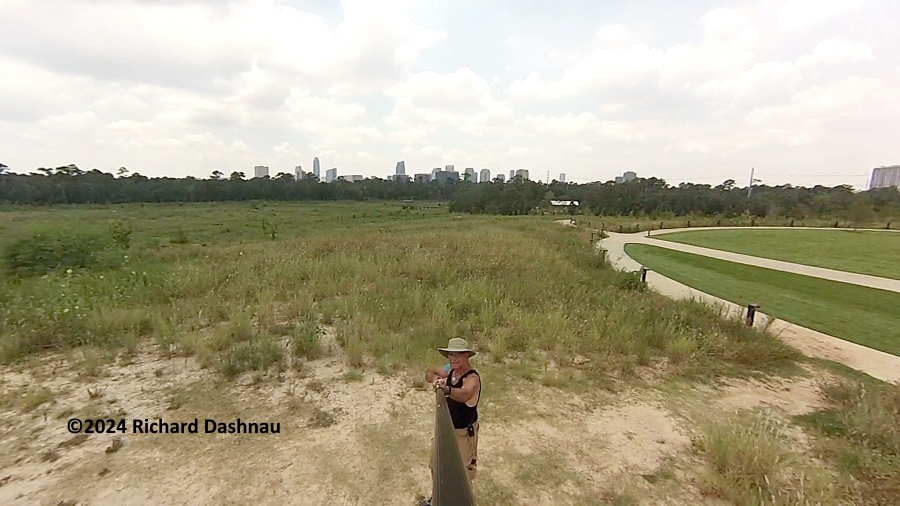
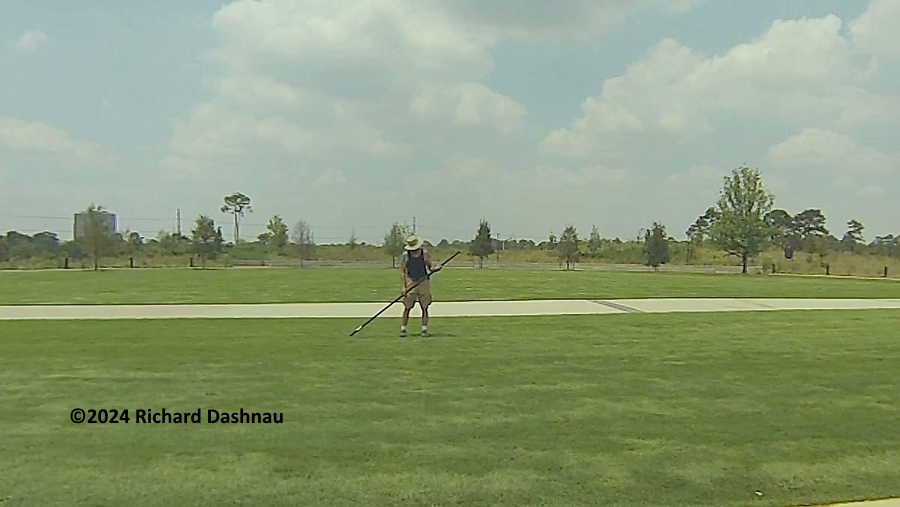
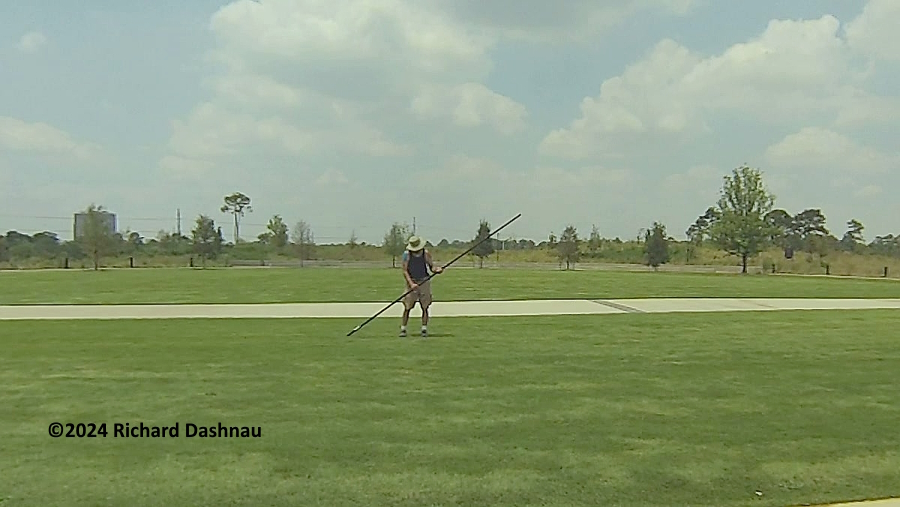
There
are only 2 sections, so it's
pretty strong, but a bit heavy
when held out at a shallow angle
(especially with a bum
shoulder). The GoPro is at
least 10 years old. It's attached
(via 1/4" threads) to a small
"UltraPod" plastic folding
tripod, which fits into the end of
the pole when folded. I used
GoPro software to remove
"fisheye" effect to make this
video.
I think the experiment
worked well. I've
edited the
video clips
into this file.
Note:8/19/2024
I've written a
document
showing how I
built this
prototype
extension arm;
also details
of the
assembly and
test of the
second
prototype.
It's in this
pdf file.
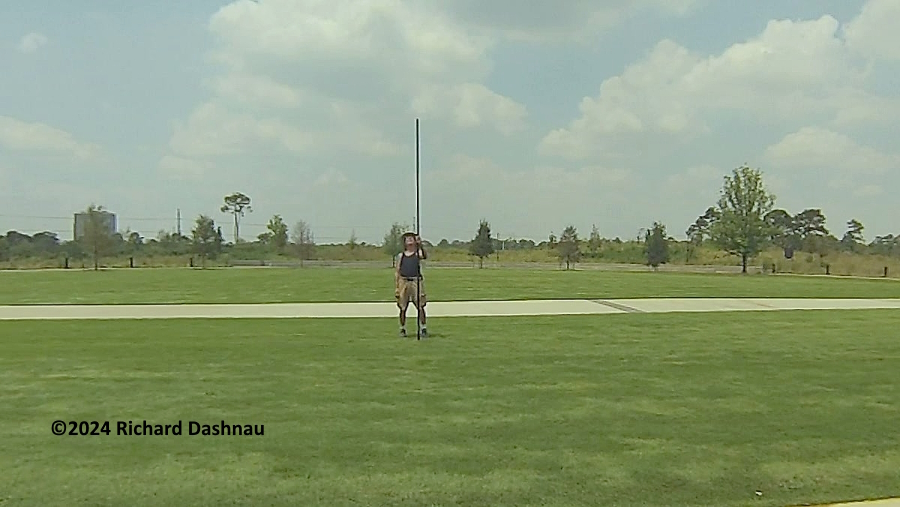
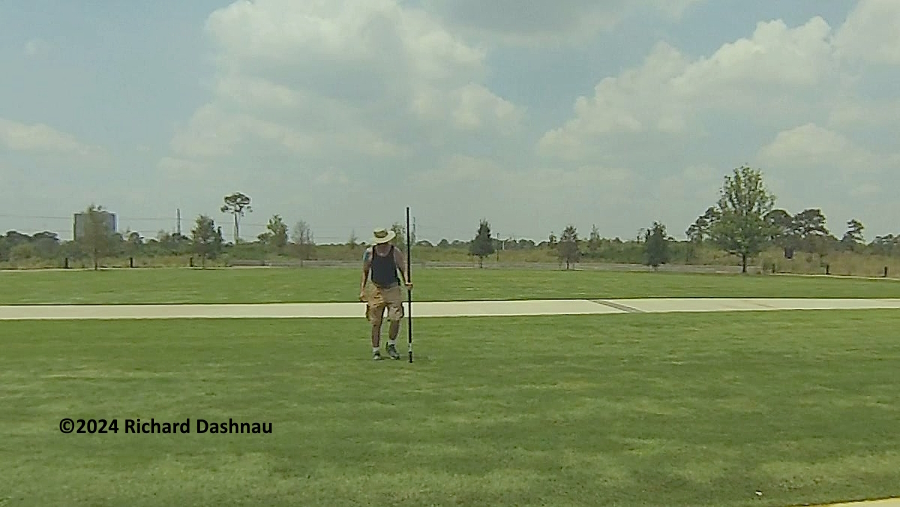
02/25/2024 Brazos Bend State Park A beautiful day, where there were
many things to see (as usual). I
started back towards my car about 2pm.I noticed something brown
about 50 yards away, and I thought it was a Nutria. But it was a
football. Now I know what the Nutrias probably do whenno humans are around.They play football. I don't
think the alligators can play because their front legs are too
short--but Nutria have little paws with claws that they can use to
manipulate plants.
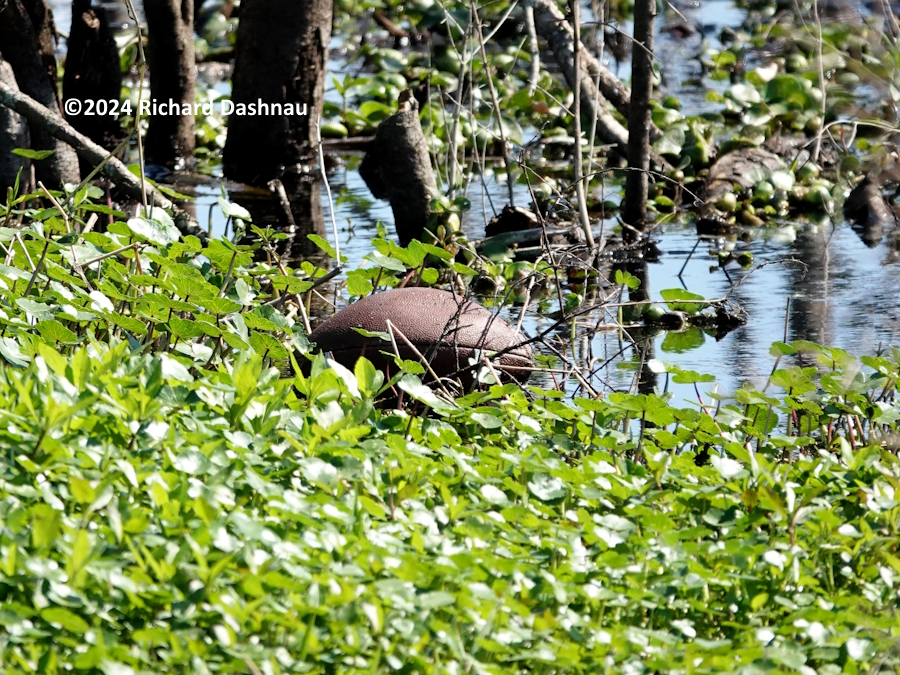
11/15/2023,Scobee
Field. Many years ago, I
had some boomerangs that I'd tossed around. I lost most of
them when Anubis, my basenji, knocked them off the wall and
chewed them up
(which was quite a trick when some were 6 feet up, and he
was 20 inches high at the shoulder). I decided to try
this again, so looked for some
boomerangs. I found a toy one (very light, very soft) and a wooden
one here in town. I had to look online for others. I
bought two plastic ones (thinking the plastic would
be harder to break). Then I went out to Scobee Field,
which has a LOT of space, to throw them.
To my suprise, one of the plastic ones broke after hitting the
ground just a few times! Probably a faulty injection
mold shot...it happens. But I threw the others without
breaking any more. The toy was very easy to toss and return. In
fact, since then (Today is 12/13/2023 and I've been tossing them
since.) I've been using it to get a quick
read on wind direction. When I threw the wooden one, I was
able to get it to turn properly, but then it stuck into the ground.
When I tried to catch this on video, I couldn't
repeat this result, and it didn't happen again. Video that I captured that day is here.
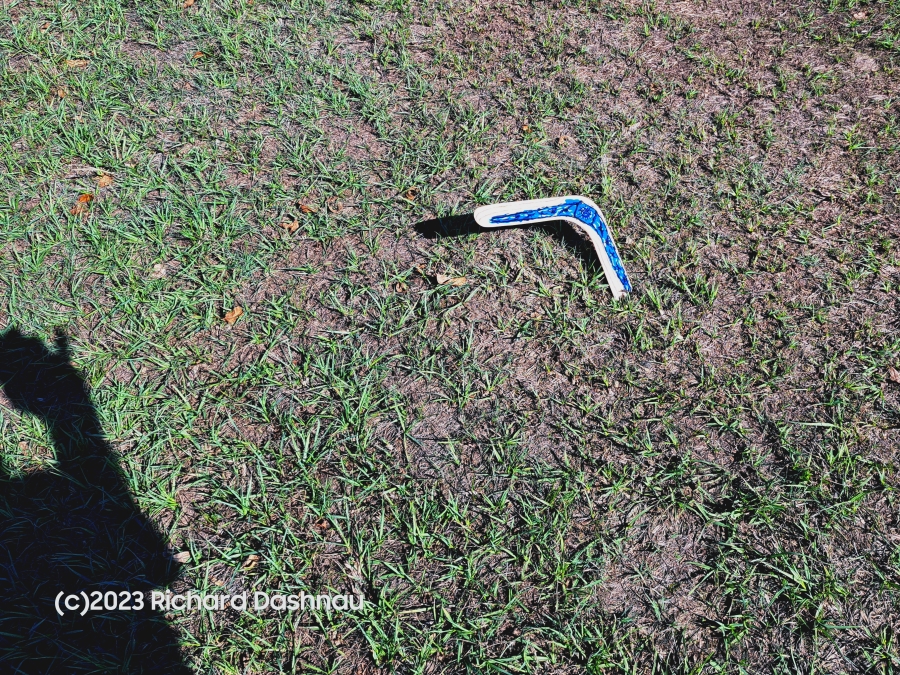
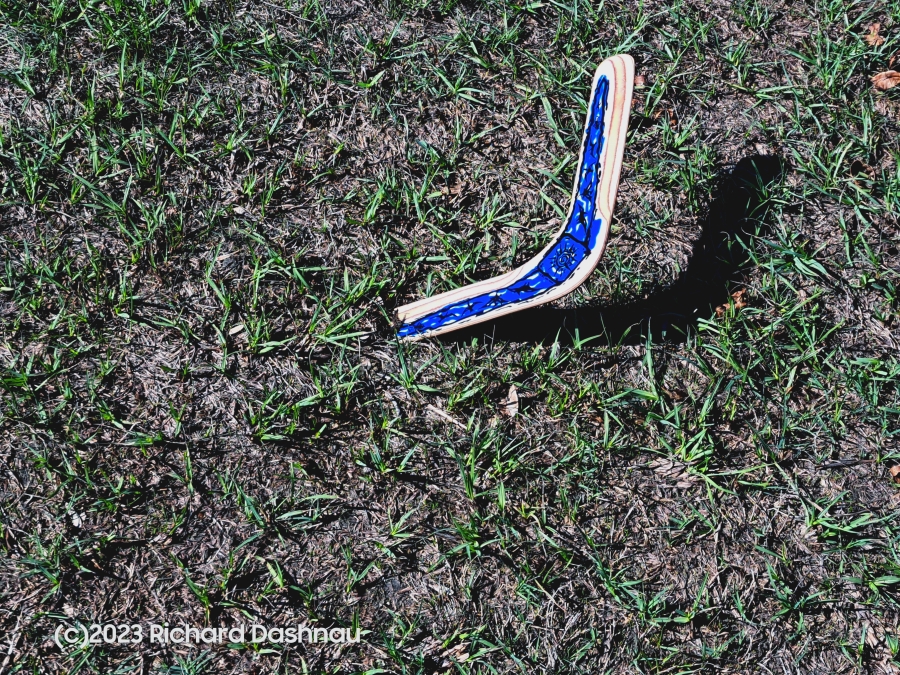
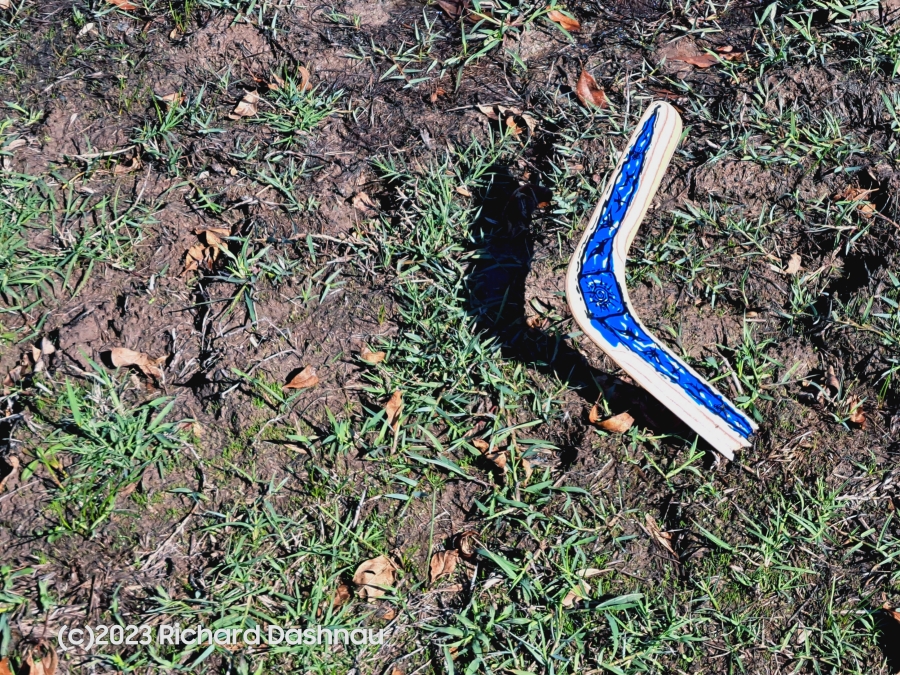
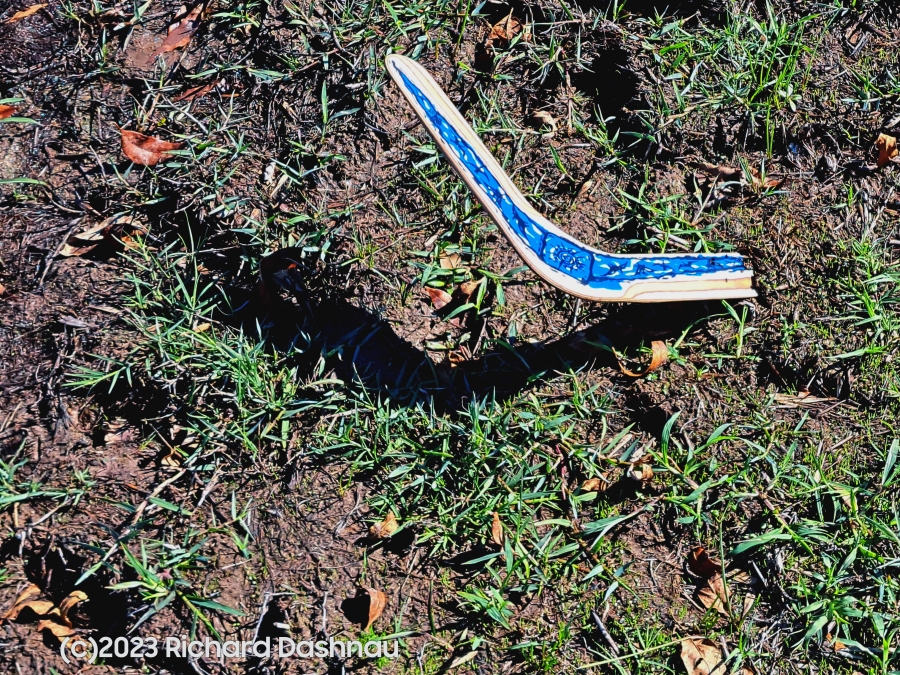
This
yellow boomerang
is a custom design, for better flight. It's smaller and lighter and
thinner than the blue one, and did return easier. I was holding my
phone and
recording video with my left hand, and throwing the boomerangs with
my right. The first 3 images below are from one flight.
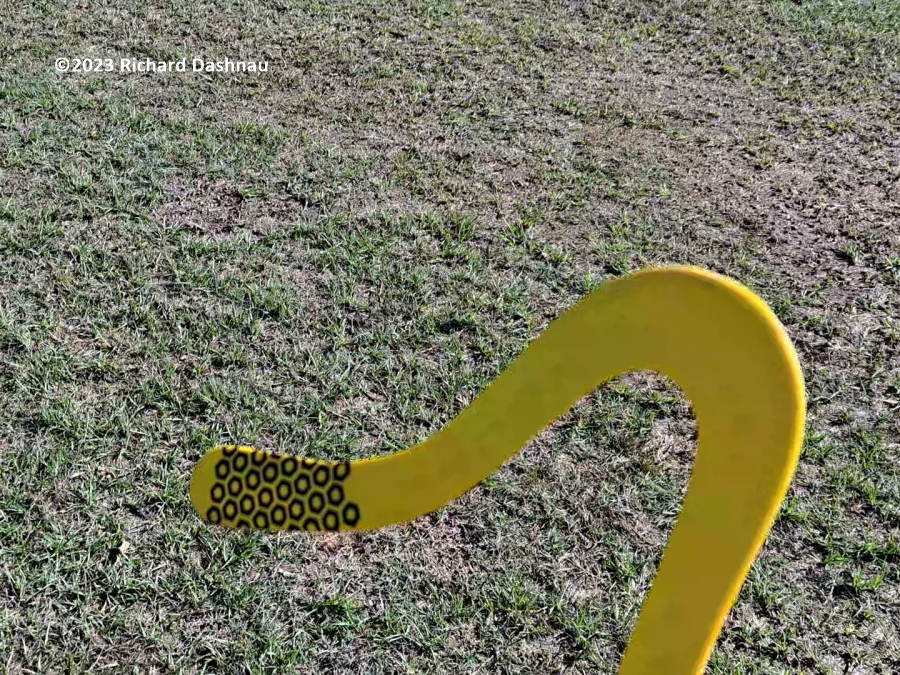
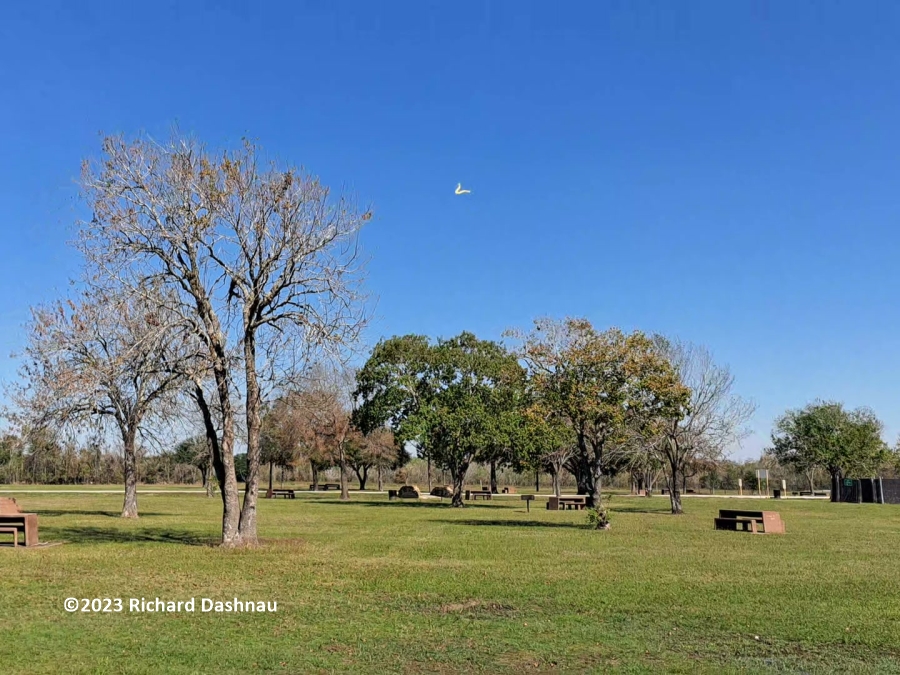
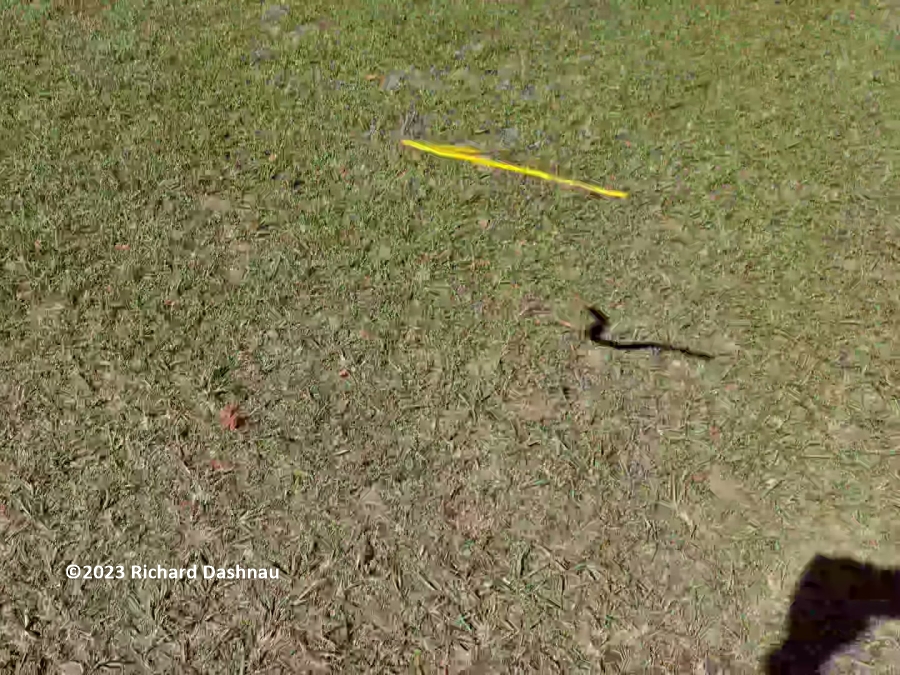
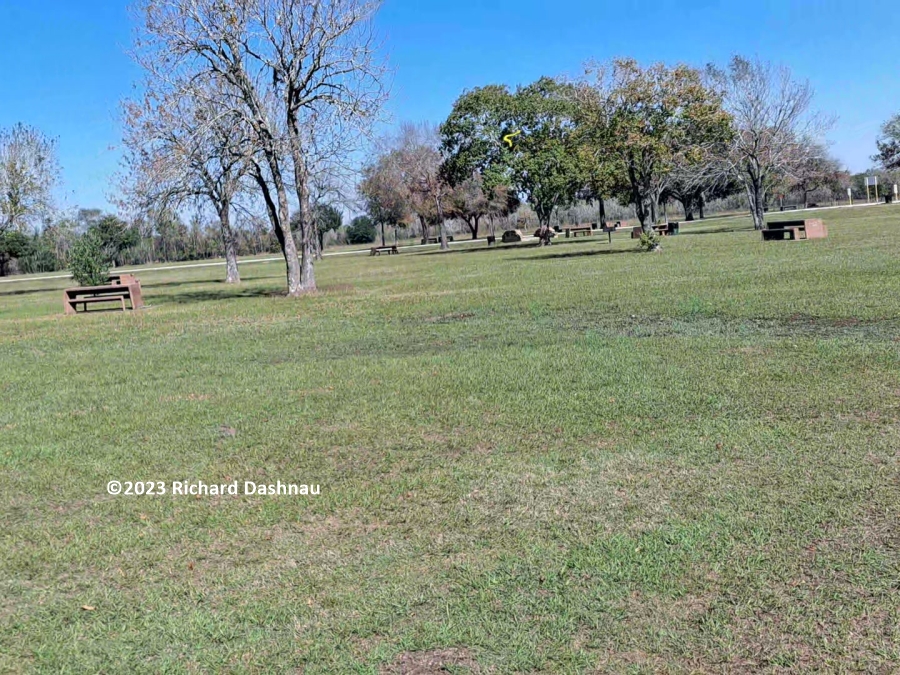
The
4th image above, and the 4 below are frames from a single throw
that came right back to me.
I stepped aside because I'm wasn't going to try to catch it
with one hand.
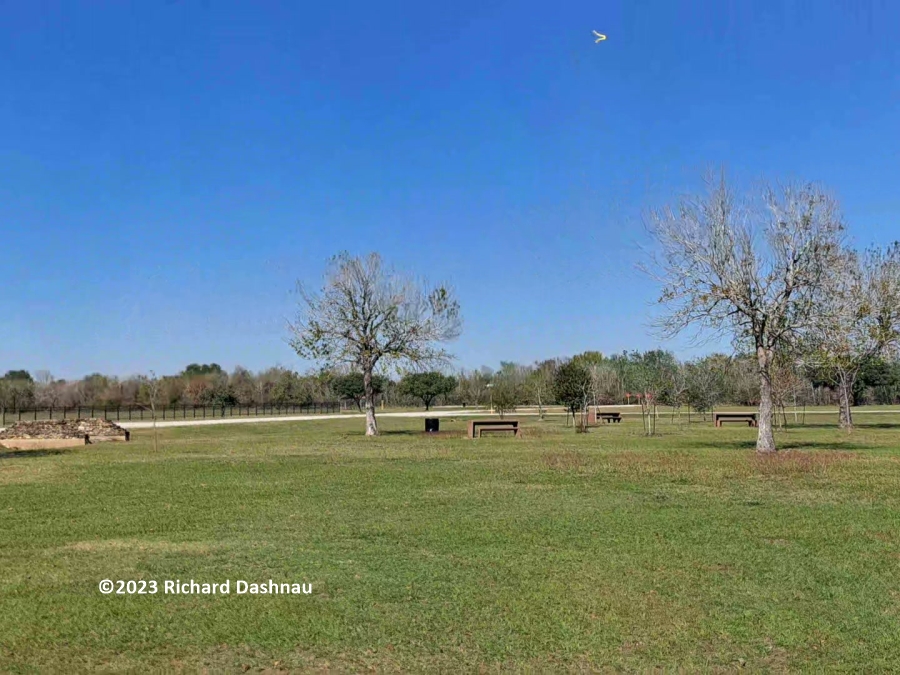
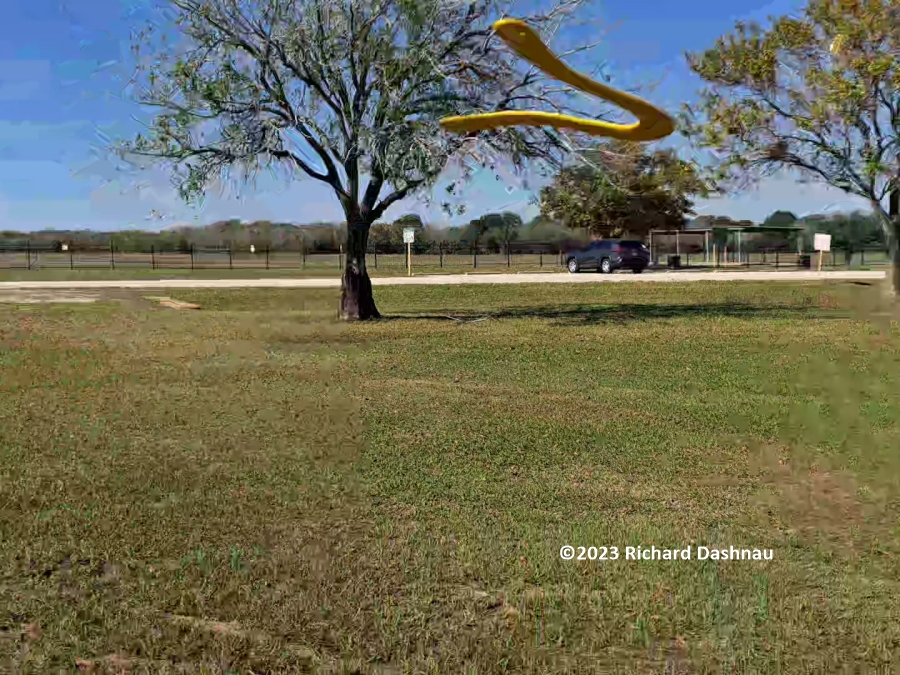
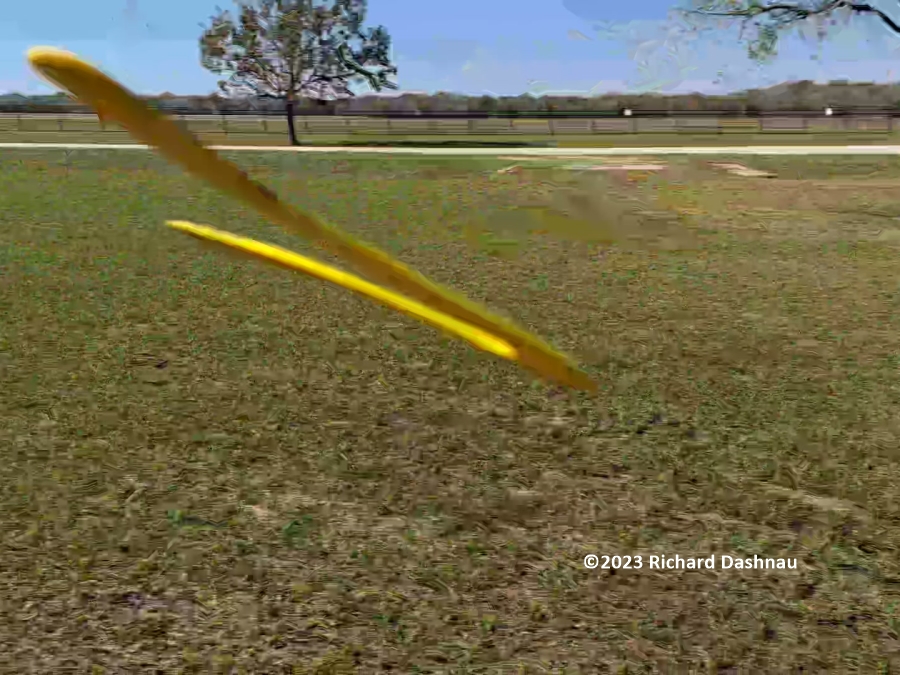
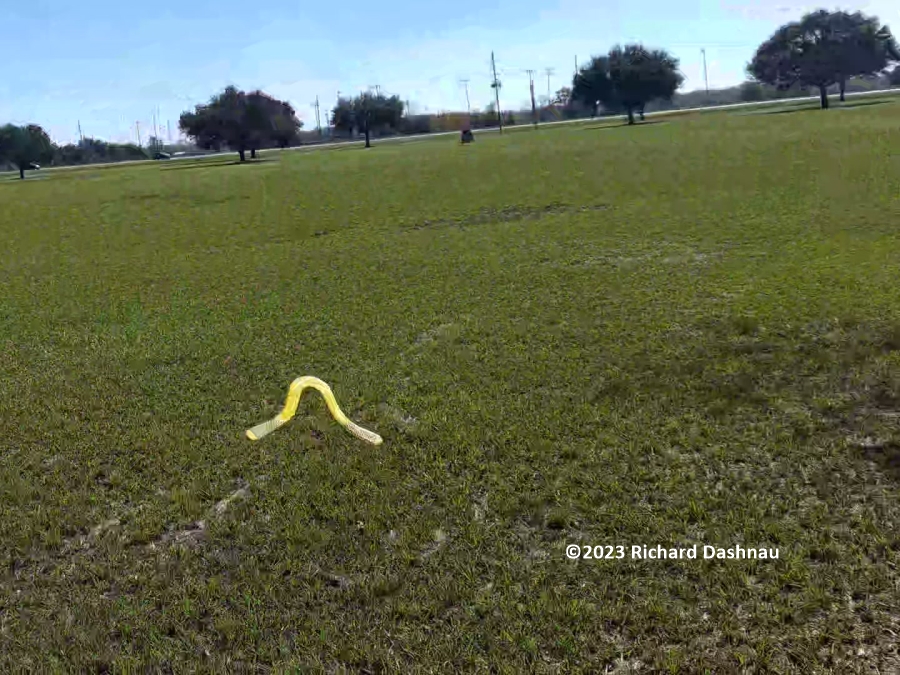
Brazos
Bend State Park 08/20/2023.
I spent 90 minutes with some visitors watching some gator drama
near the 40 Acre Lake Observation
Tower. A few visitors that had walked down the Spillway Trail from
Elm Lake mentioned that they'd seen baby alligators along the way.
I tried to figure
out where they'd seen them-since I knew about 2 nests there.
In
this
weather (Temperature had been near 100F), keeping hydrated is
important. For years, I've
used a 2-liter Camelback water pack. For additional comfort,
I fill it with ice and cold water before I leave home. Since I
have the thermal camera, on 8/13/23,
I
imaged myself to see what's hot and what's not. It's not
designed for shooting timed "selfies", so I had either get close
enough to trigger it manually, or shoot
video. I did both. The 3 images below are frames from video
taken at the Spillway Bridge about 11:30am.
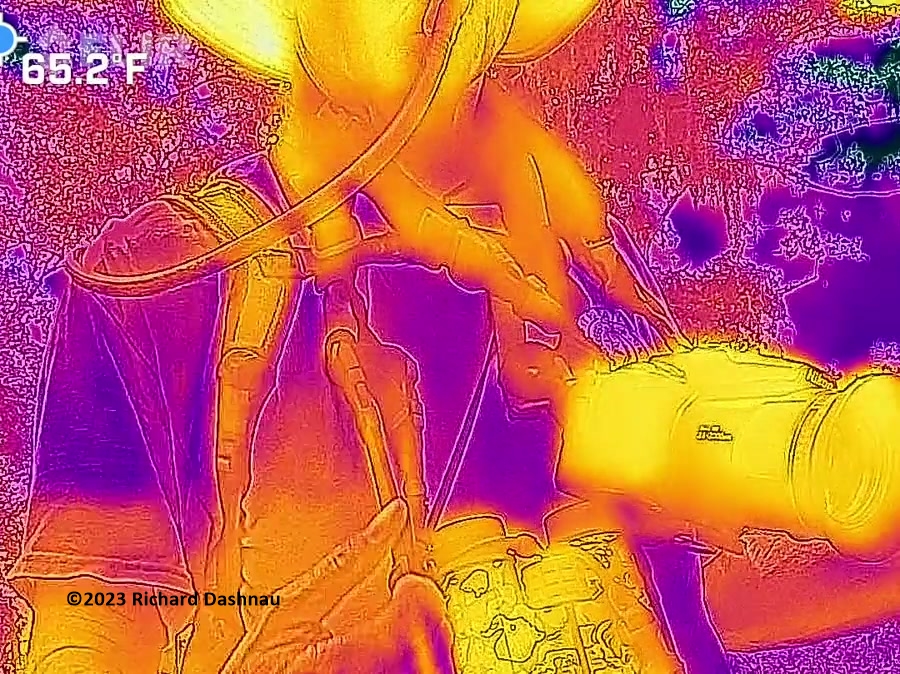
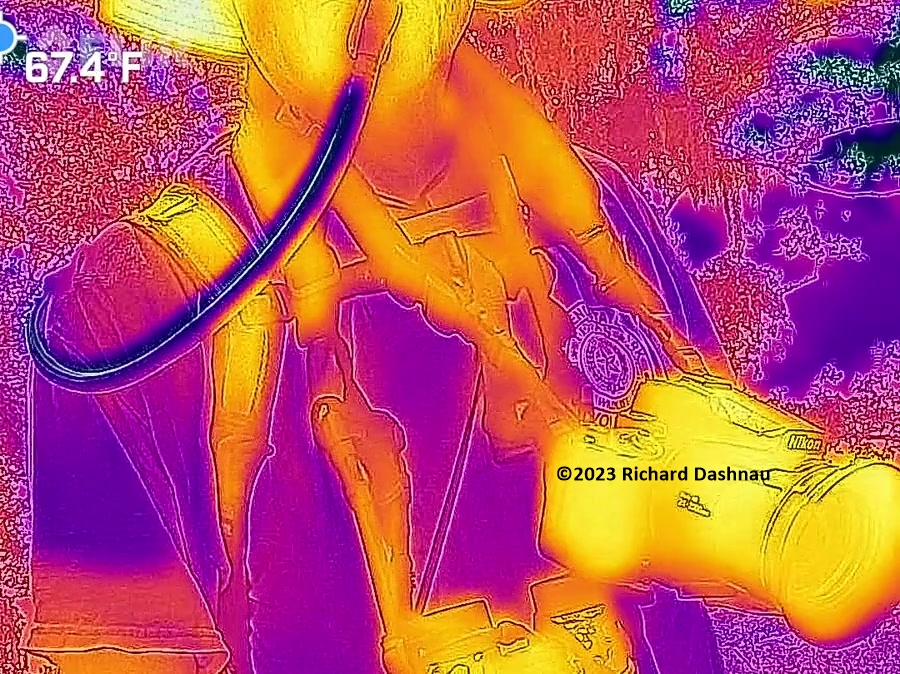
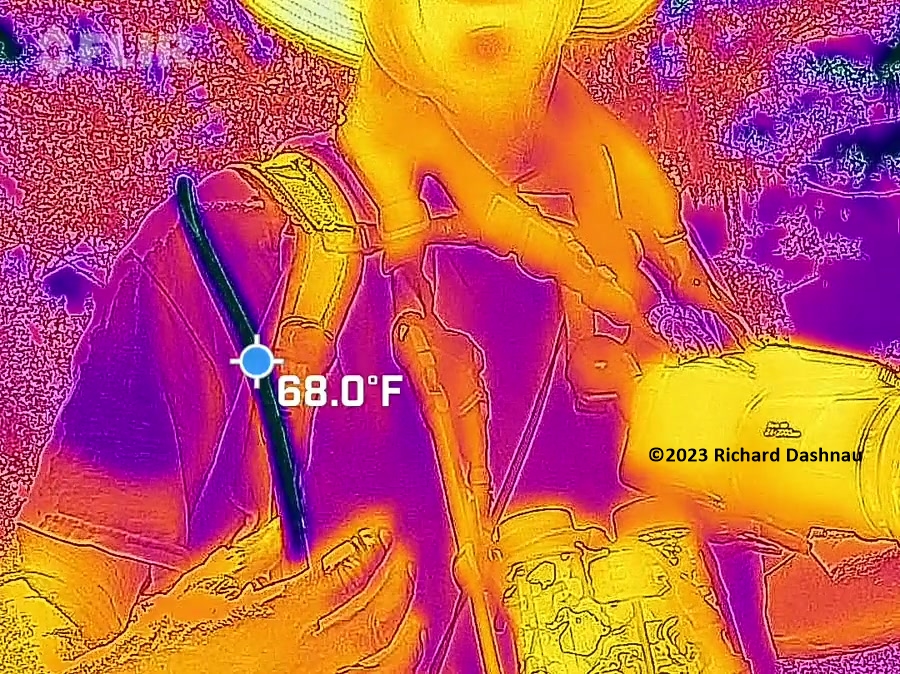
The
4
images below were taken in the shade by the 40-Acre Lake
parking lot about 1:08pm. I had taken off my cameras,
changed my hat, and added a bit of
water to my nearly-empty water supply. I can pull
data off the the photos, so added sense points to the first image.
The other images are frames from video.
In all images, darker colors are cooler. My shirt is cooler
due to evaporative cooling of sweat (Hooray for the breeze, and I
was soaked with sweat!), and the
tube from the Camelback got a lot cooler when I drank from it.
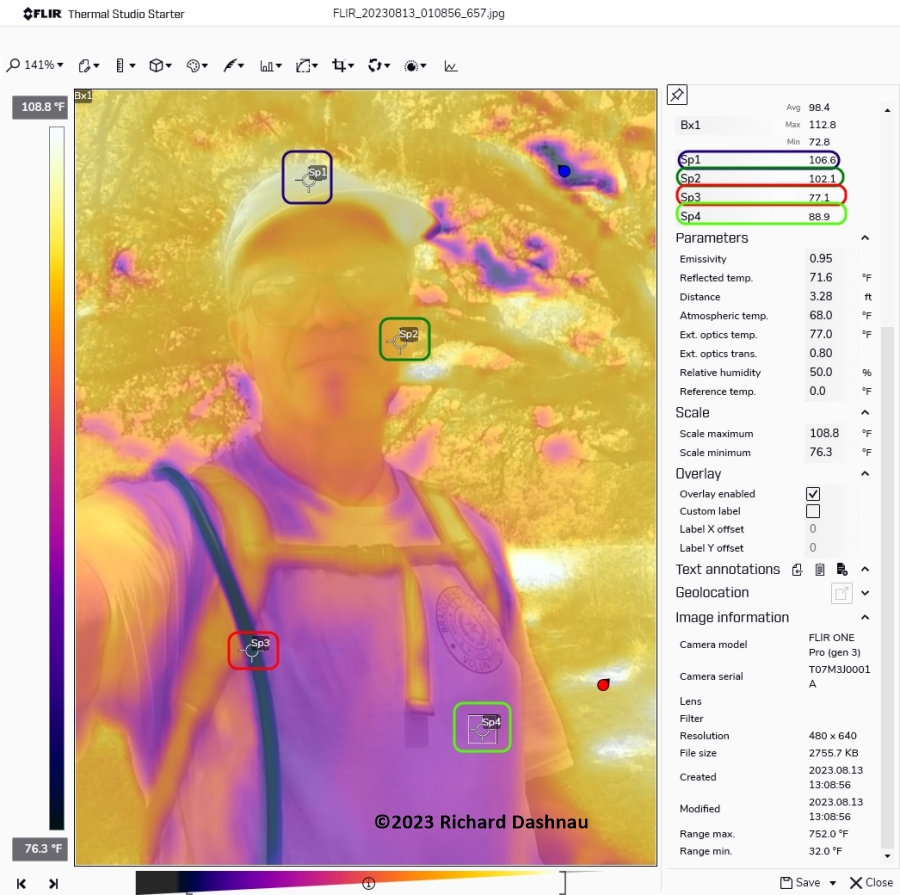
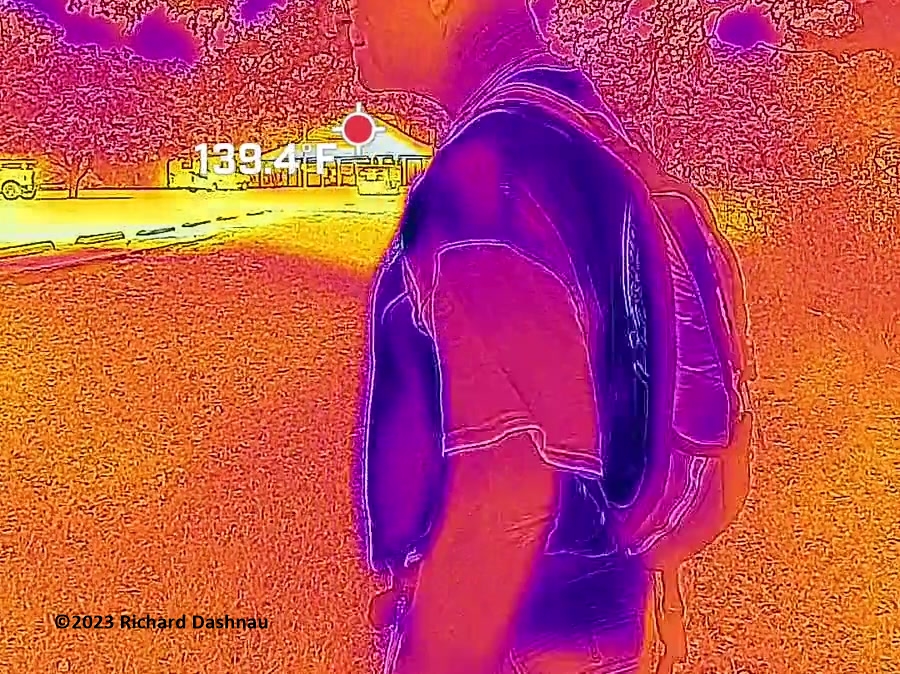
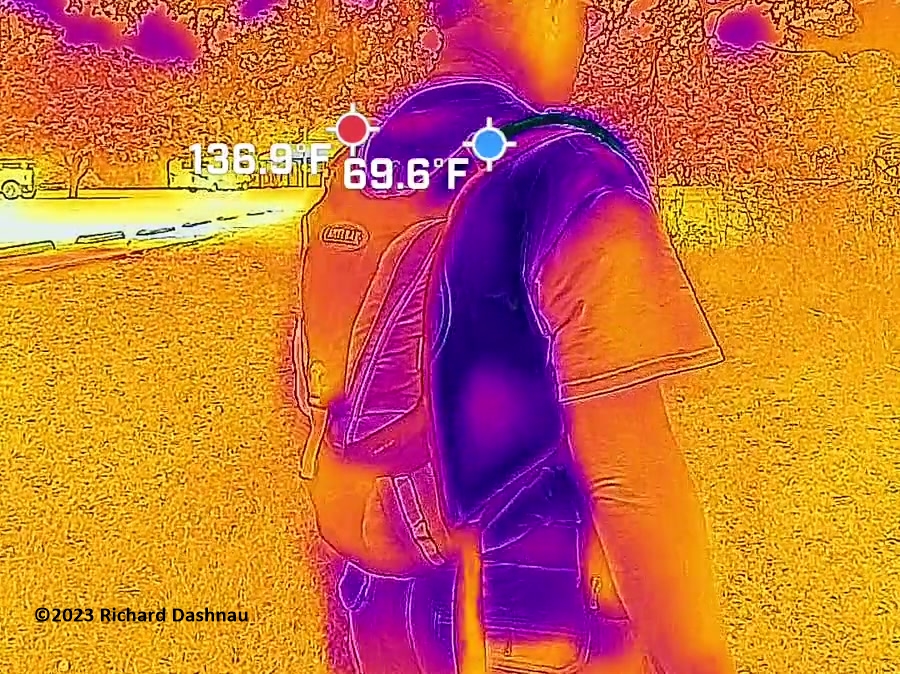
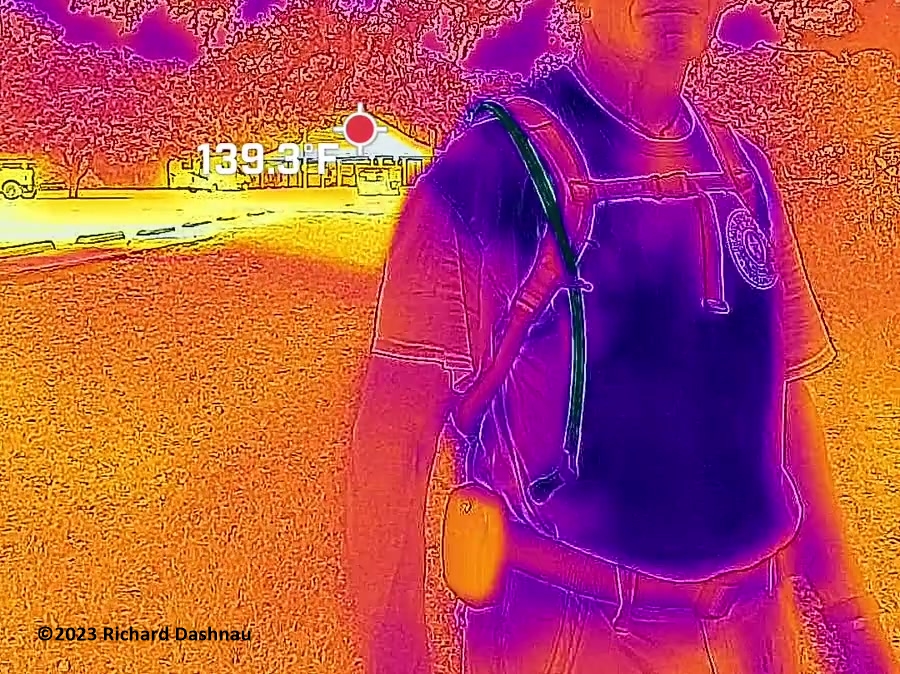
06/29/2023. I use a
plastic bottle containing ice to maintain something cool to drink
while I enjoying recreation outside during this hot weather. I
built a foam
sleeve to preserve the ice as long as possible. I used my FLIR ONE
usb to check the insulation value of my foam sleeve. The software
allows for detailed
analysis when I copy the images to my PC. I can screengrab the
results, as shown here. This was after 90 minutes in a closed car.
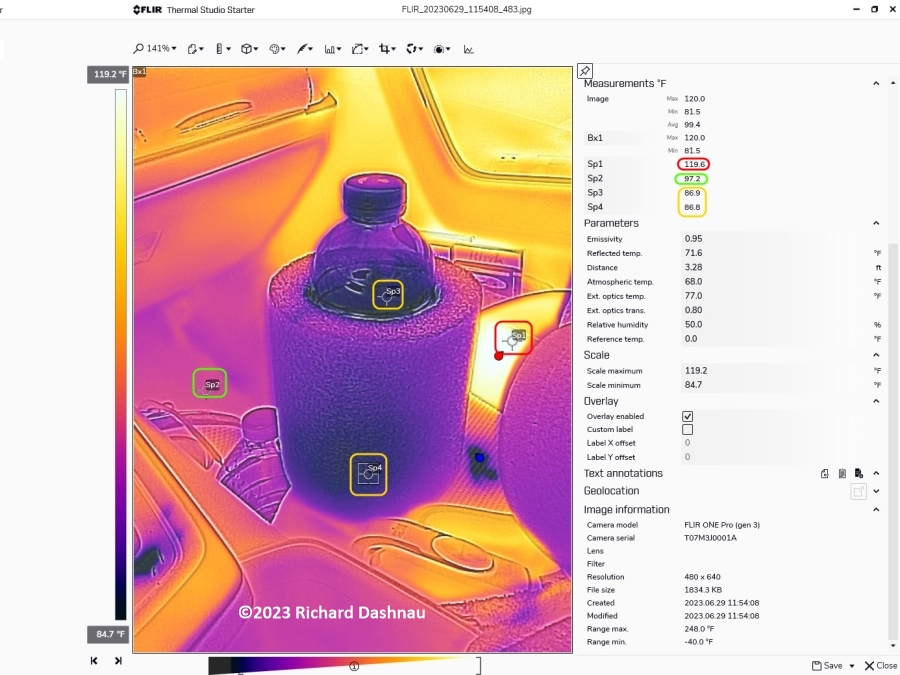
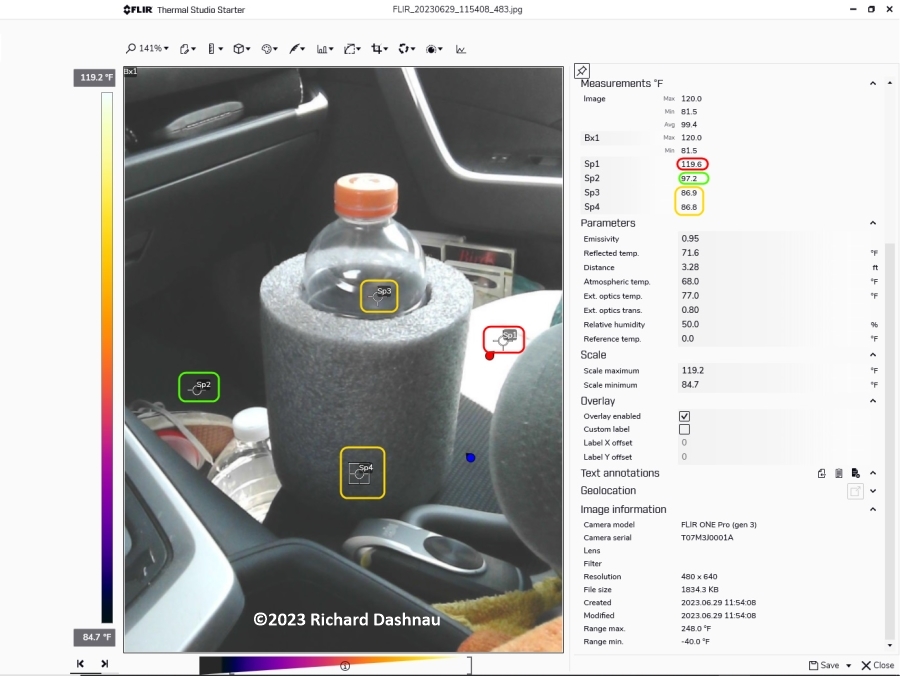
Another
image,
with the bottle out, and different markers placed. Once an image
is captured, various items can be modifed to clarify data. A
thermal camera
alone usually has poor resolution, but the FLIR one merges two
images for clearer definition.
And final example, the same image with the markers placed,
but
with the thermal image removed, leaving the temperature values in
place. I still had ice, but the water around it was warmer. I'd
bought this device for certain
wildlife experiments-which the current weather has delayed a bit.
However I had some success with my first field trial in March.
Those can images are far down
on
this page.
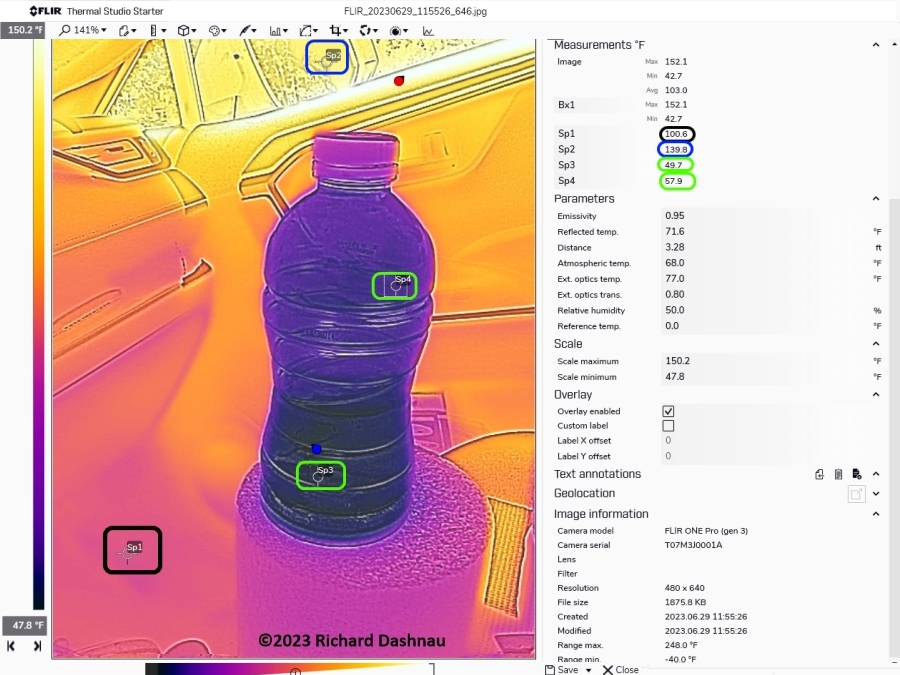
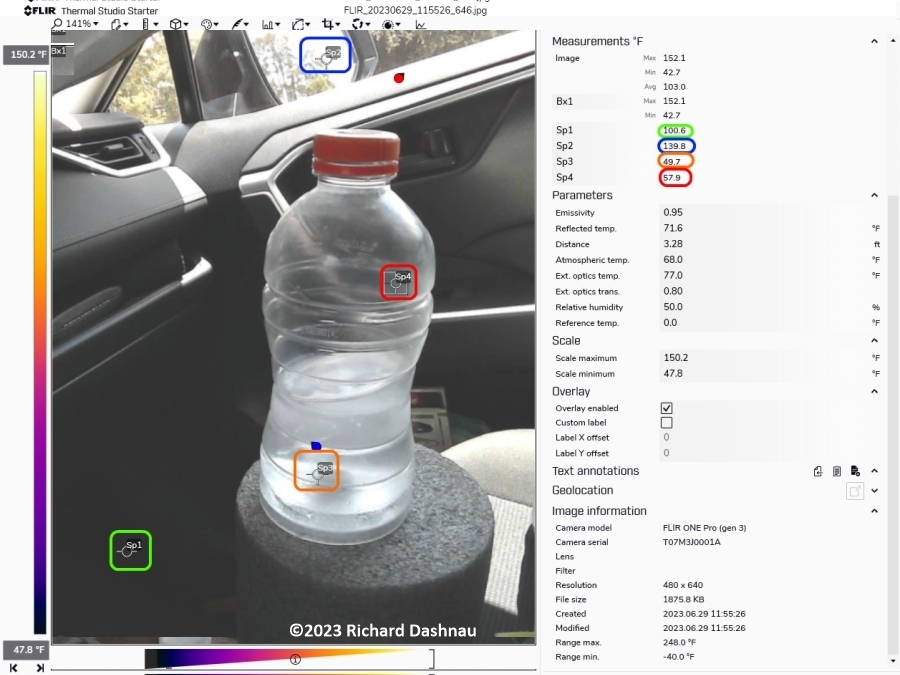
11/18/2017 The Weiss
Energy Hall has been closed for about a year. It is to be re-opened to
the public 11/20/2017. I went to a members' sneak preview. Here
are some images
showing the new marine
seismic acquisition section. The last image below right is a
frame grab from short video clip showing the opration of the
seismic air gun (PAR-pneumatic
acoustic repeater) . The gun can be fired "on demand" by pumping
up the display control chamber. This video clip shows
it in action.
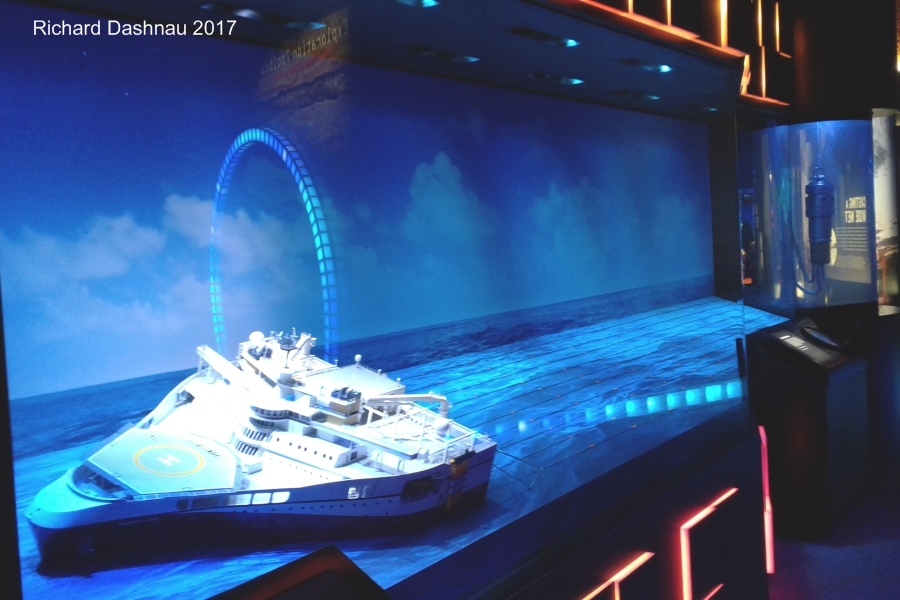
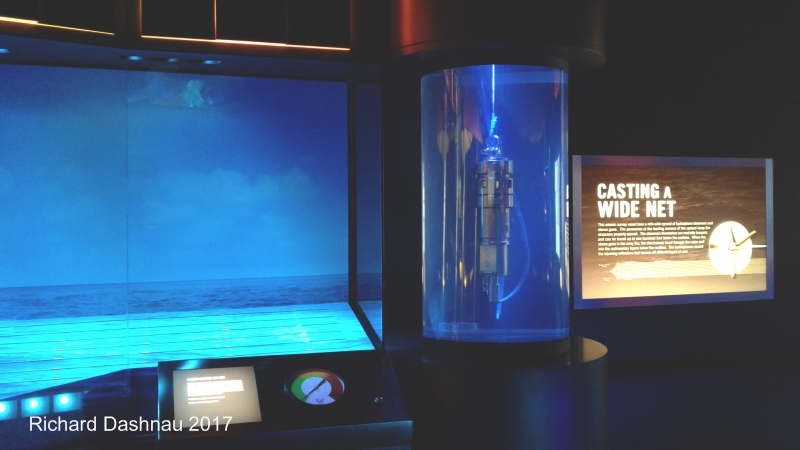
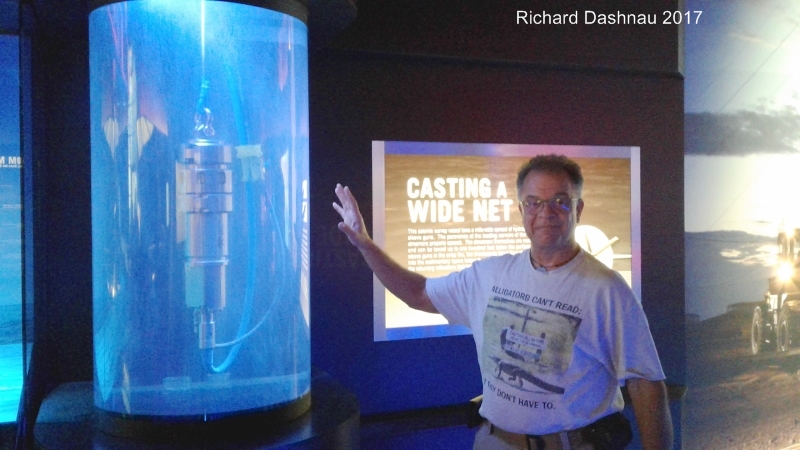
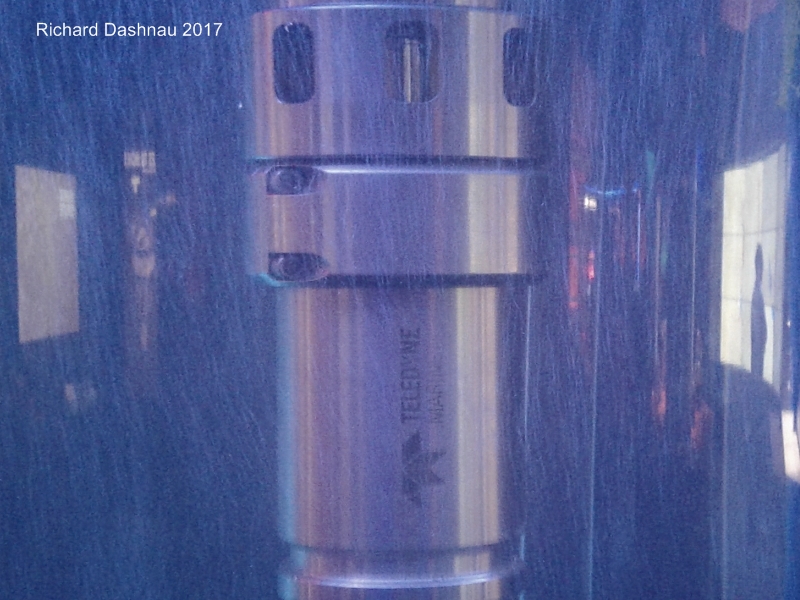
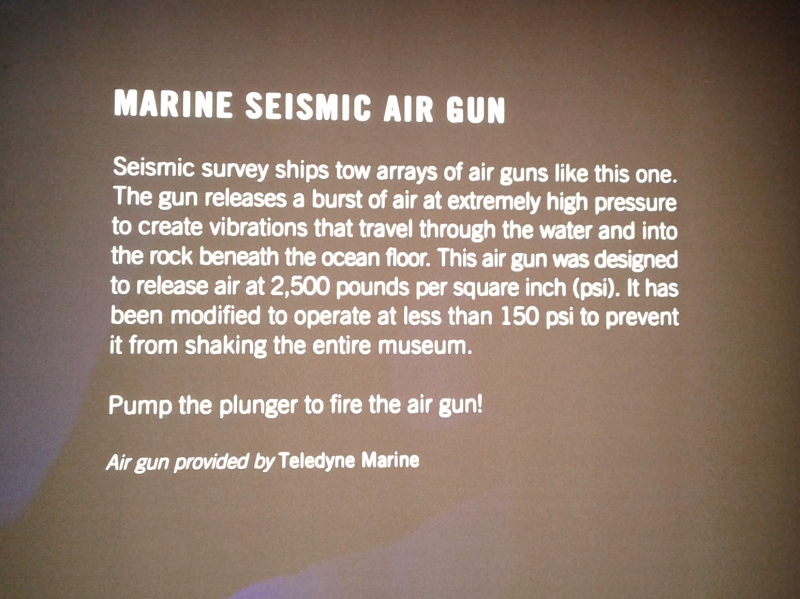
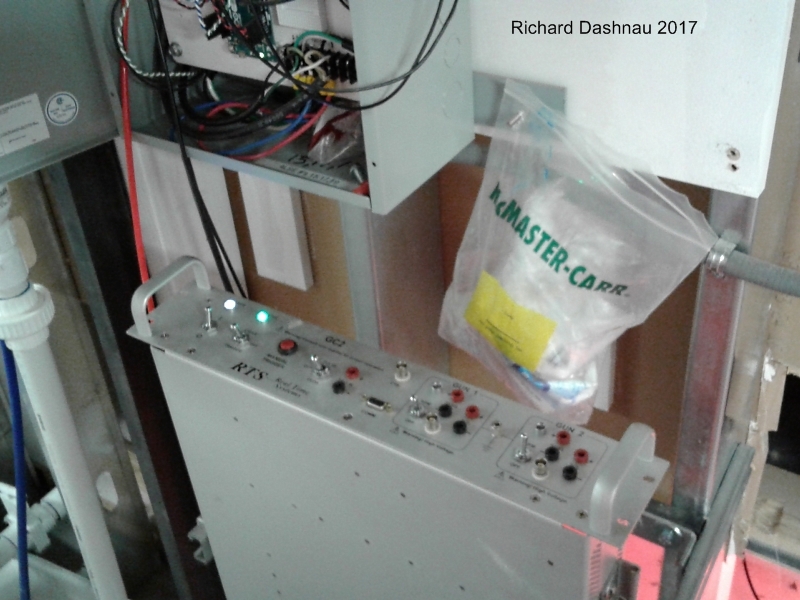
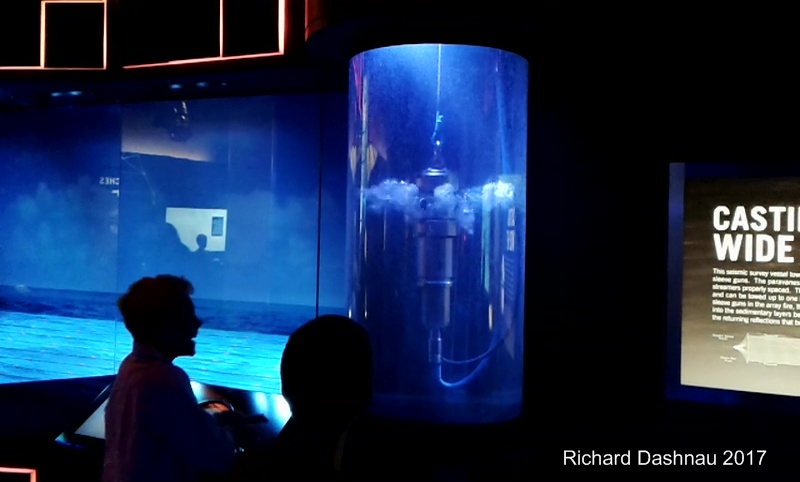
7/24/2016 Brazos
Bend State Park reopened this week! Even this long after the flood,
the park shows signs of what the high water had done. In this long
panorama shot, here are
two interesting examples. 40 Acre lake is almost totally choked by
Water Hyacinth. But....Pilant Lake is more open than I've ever seen it in
14 years! Take a look. Click the image to
see a larger version--then scroll across.

And another wonderful thing! The Golden Silk Spiders (Nephila
clavipes) have come back. The numbers of these spiders had dwindled since
the big drought of 2011, and on some
trails where I'd previously seen hundreds or thousands....I saw few. In
fact, so few that I didn't feel comfortable disturbing any of them.
This year, there are many more, and I was able
to gently borrow one from her web to show to some park visitors.
Afterwards, I placed her back into her web. Here she is:
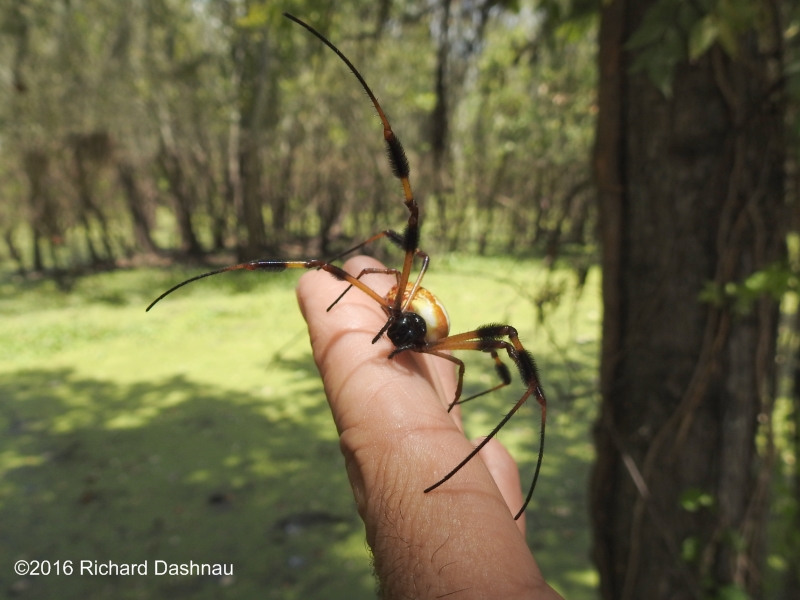
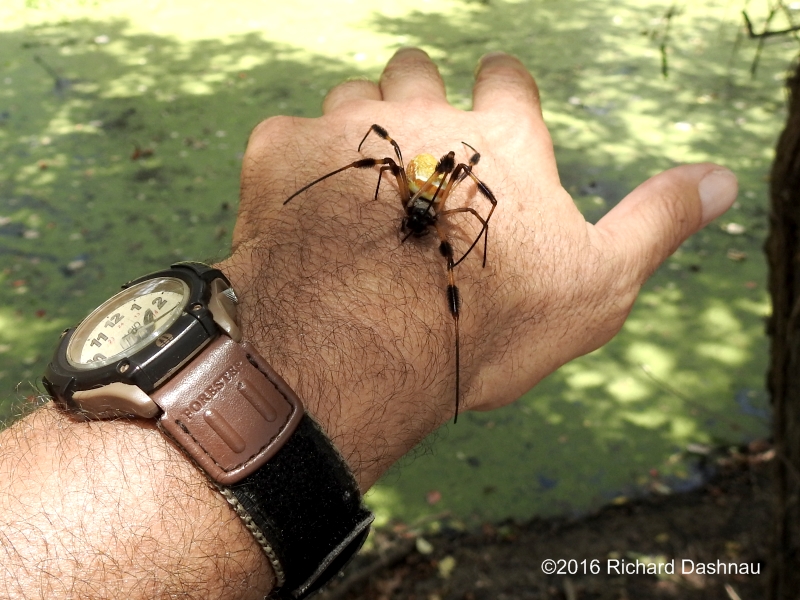
10/23/2015 I visited HMNS on Friday, and I saw the
Chronophage clock in the Grand Hall. According to information on
the HMNS website, this is one of the 4 Chronophage
clocks of this design in the world. I was impressed by the style
in the design, and after watching a video about its construction
and operation I was even more impressed.
Below are 3 animated gifs I made showing the movement of the
"insect" at the top.
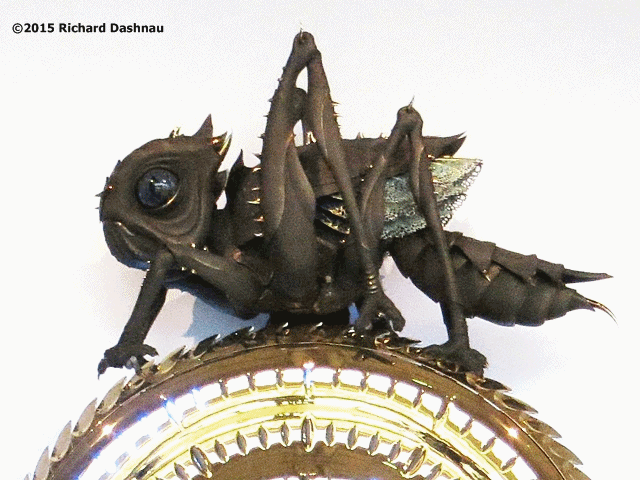 ------------
------------ 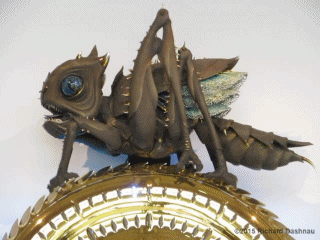 ------------
------------

This is a working mechanical clock, powered by actions of the
pendulum and the"grasshopper escapement". The clock is 1.5
meters across (about 5 ft).
The "grasshopper" escapement was designed in 1722 by British
clockmaker John Harrison. This refers to the actual
mechanism of the clock, which is just modified to
look like a "grasshopper".To acknowledge and demonstrate the
escapement John C. Taylor designed the Chronophage clock.
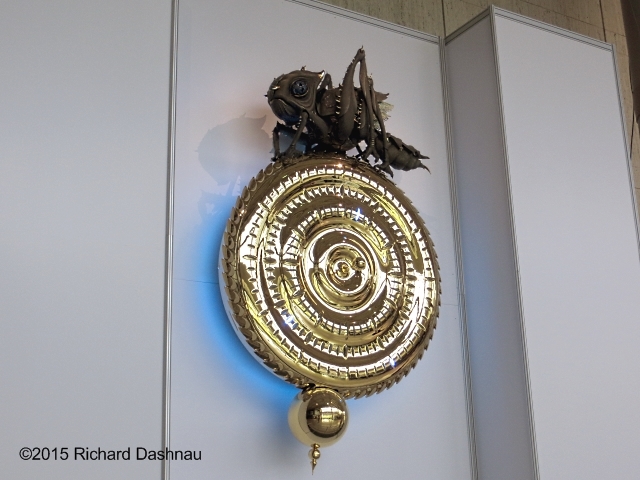
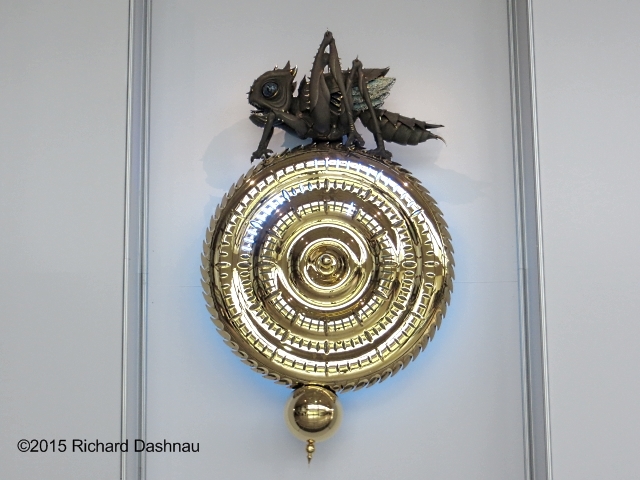
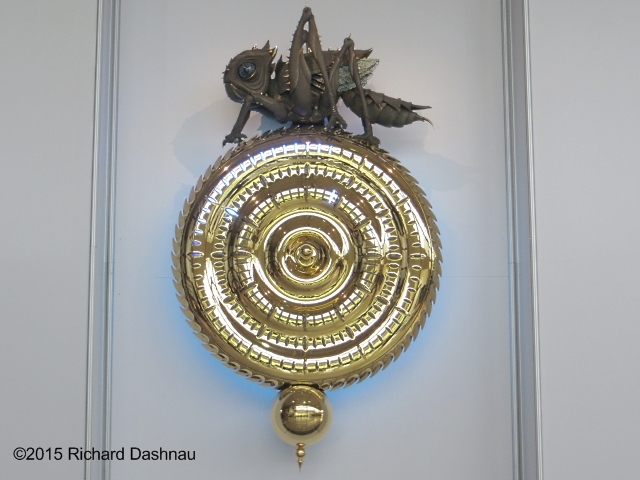
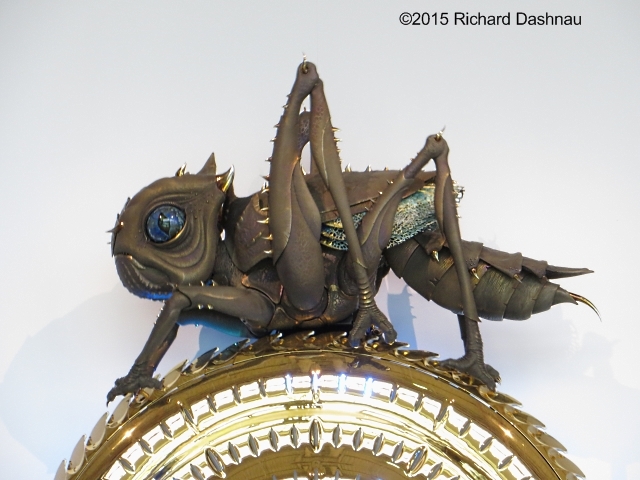
The clock may stop occasionally, or even reverse itself, but every
5 minutes it gives the correct time, and shows it in 3 concentric
rings. Outer is seconds, then minutes, then hours. The
lights
seem to rotate, but are actually rings of LEDs that show only when
a single opening passes in front of each one. Every 60 seconds, it
opens its mouth to devour a minute, and every hour, the
Chronophage lights up and sings. According to the HMNS
website, the clock's face is gold-plated stainless steel. The
stainless was shaped by explosive hydroforming.
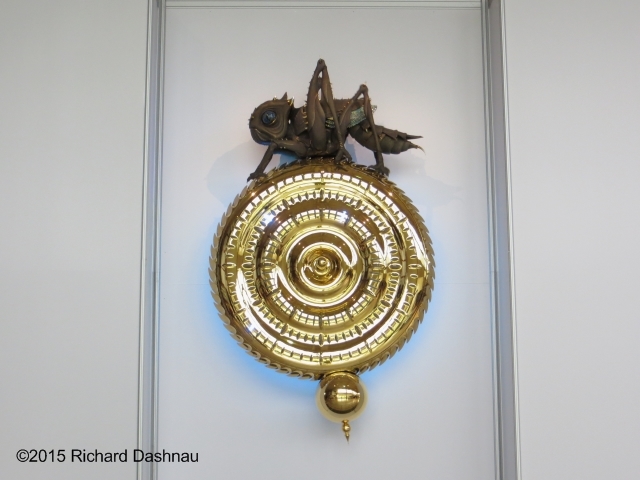
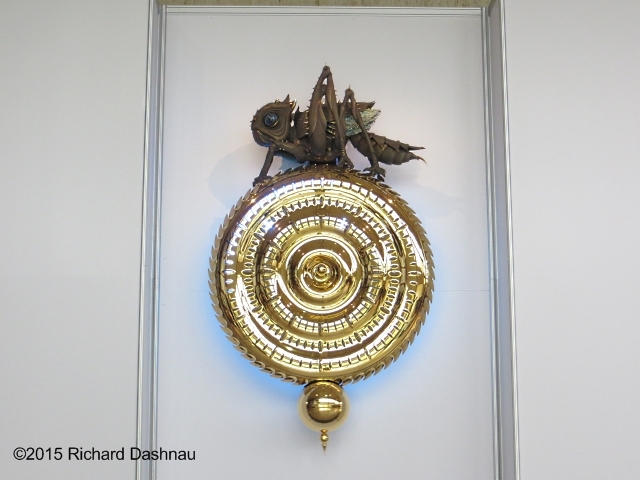
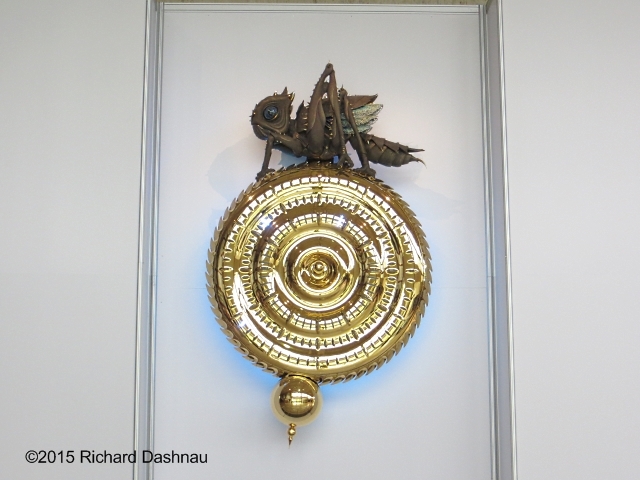
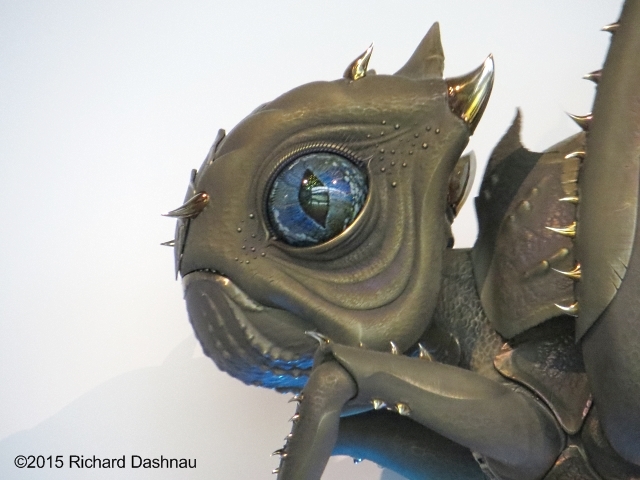
It's a fine example of artistic appliance (it *is* a clock, after
all), and I'm glad I took the time to see it. The only
information I can find says that it will be in HMNS from 8/24/15
to 12/31/15.
So, it won't be here next year. If you can't get out to
Houston Museum of Natural Science to see it, then maybe these
images will show enough. Or, click the following links to see some
video clips
of the Chronophage: clip 1(wmv) clip 2(wmv) clip 3(wmv)
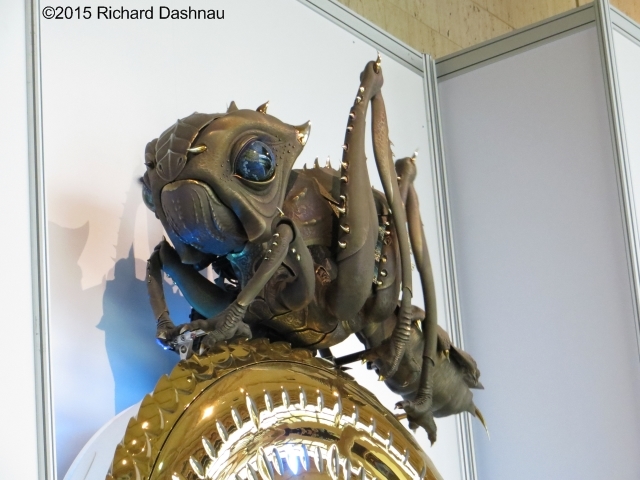
The 4 Chronophage clocks that I could find on the internet are at
the following links.
"Untitled" -- which is the one currently at HMNS
Corpus -- http://www.johnctaylor.com/the-chronophage/corpus-chronophage/
Midsummer -- http://www.johnctaylor.com/the-chronophage/midsummer-chronophage/
Dragon -- http://www.johnctaylor.com/the-chronophage/dragon-chronophage/
And more information is here: http://www.johnctaylor.com/2015/02/twelve-things-you-didnt-know-about-iconic-chronophage-clocks/
Just in case the links to outside pages go dead, the list below is
from www.johnctaylor.com
Here are twelve facts that most people don’t know about the
Chronophage clocks:
1. The name ‘Chronophage’ is derived from the Ancient Greek words
‘chronos’ meaning time and ‘phage’ meaning eater.
2. Dr Taylor, the creator of the clocks, also invented the
cordless kettle. He has over 400 patents to his name, six of which
pertain to the timepieces.
3. Dr Taylor is also a leading expert on the work of John
Harrison, an eighteenth-century English horologist who built the
first marine chronometer, allowing seafarers to determine their
positions
at sea.
4. Each Chronophage is three metres tall, and the 1.5 metre
diameter clock face is plated in 24 carat gold.
5. The clocks only show the correct time every five minutes.
Exploring Albert Einstein’s theory of relative time, they slow
down, speed up and occasionally stop.
6. The clock faces have no hands, but instead tell the time with
three concentric circles of blue light-emitting diodes (LEDs). The
lights do not flash on and off but are obscured
and revealed by three stainless steel discs, each with a ring of
Vernier slits. When the slits align, the lights are visible. The
outer ring shows seconds, the middle shows minutes
and the inner ring shows hours.
7. The dragon on the Dragon Chronophage was designed by Professor
Long of China Academy of Art in Hangzhou. The design is
authentically Chinese – for example, the dragon is
accompanied by a pearl, which it swallows every hour. The pearl is
a symbol of purity and prosperity.
8. Since its installation in 2008, the Corpus Chronophage has
become one of Cambridge’s most popular landmarks. In 2014 the Tour
de France passed the clock in its early stages.
Vincenzo Nibali, the first rider past the Chronophage, went on to
win the Tour.
9. Each of the creatures is a part of the clock’s mechanism. The
technical name for this component is a ‘grasshopper escapement’
and it was invented by one of Dr Taylor’s greatest clockmaking
influences, John Harrison.
10. The distinctive rippled effect on the Chronophage clock face
is created using underwater explosions, and depicts time moving
outwards from the centre of the universe after the Big Bang.
11. The construction process is so complex and meticulous that
only four Chronophage clocks have been created.
12. The Dragon Chronophage is valued at over �3 million, making
it one of the world’s most valuable modern clocks.
09/14/2014
Vampires at
Brazos Bend State Park! ....sort of. While walking the Spillway
Trail near the Alligator Nesting Display, I noticed an area of vegetation
covered with orange string-like
growths. This was near one of the islands, so I had to examine the
growths through binoculars. Some years ago, I'd seen areas like this, and
I'd asked David what they were. He had told me
what it was then, and...I had forgotten. Fortunately, I was able to
ask David again, and he refreshed my memory. The growth is called
"Dodder", and it's a true parasite. That is, it survives
entirely by sucking what it needs from the plants it grows on. There are
many varieties of Dodder (which are plants in the Cuscuta genus). Some of
these are native, some invasive. Dodder
plants grow from seeds. When the seed germinates, the new shoot starts
questing about for a nearby host. They "move" as ivys or similar plants
do, but experiments have shown that they
grow towards other
plants, and not in random directions. When they reach a host plant (and
they can use many different types of plants), they wrap around it. Then,
theygrow shoots, called
haustoria, that penetrate the plant and join with the host plant's
vascular system. The original roots are discarded, and the dodder begins
living off the host plant. Recent studies have shown
that along with the necessary plant materials (water, sugars) the dodder
and the host plant also exchange mRNA (messenger RNA). Further studyis
needed to understand what effects this
can have on both plants, but it's possible the dodder could influence the
host to either lower its chemical defense, or even to produce more
nutrients to benefit the dodder. So, although this
botanical "vampire" can't turn into a bat it *might* be able to
"hypnotize" its host.
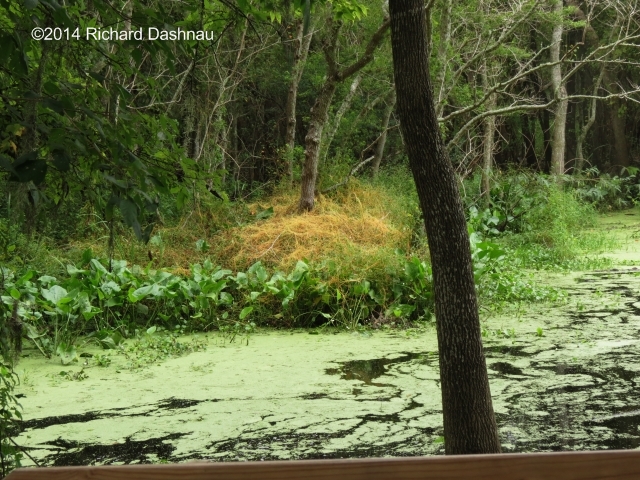
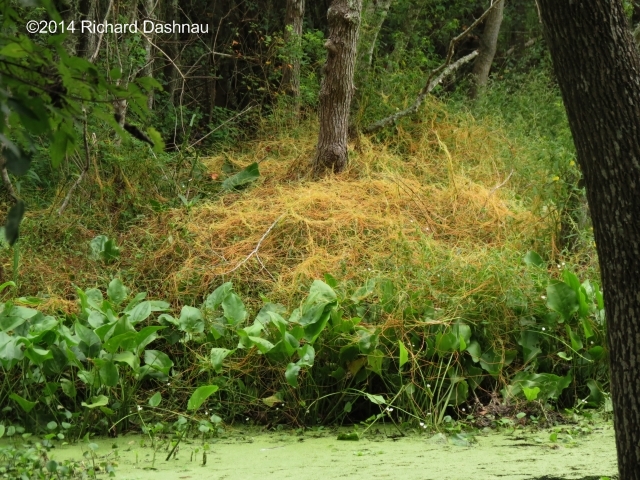
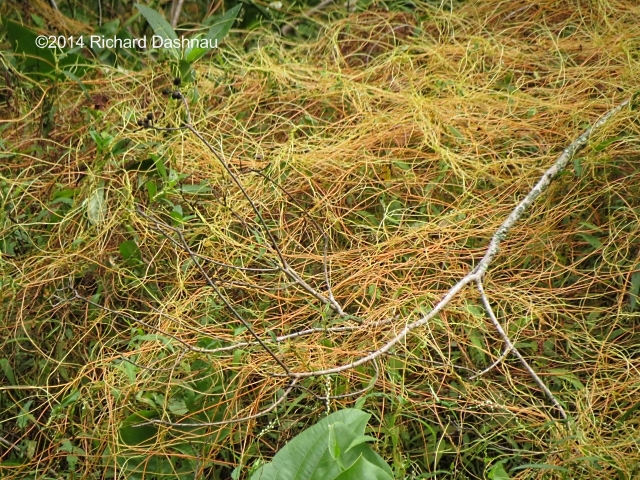

Here are some links that talk more about Dodders:
locating hosts:
Locating
1
Locating
2
exchanging chemistry:
chemistry
1
chemistry
2
chemistry
3
chemistry
4
chemistry
5
May
25, 2013-- SPECIAL UPDATES:
On
4/20/2013, I recieved the following email (quoted with permission):
"Rick,
I read your
page on Wyrex and noticed your comments about her missing tail. When
we excavated Wyrex, we searched and searched for more tail vertebra
but none were found. Wyrex was
laying on a fairly flat plain and none of us could figure out where
her tail was. However during the prep work on her, it was discovered
that her tail had been bitten off long before her juvenile
death. At that time it was discovered that the pathology showed that
it had healed a estimated that it did not cause her death. Not sure
what the sign at Houston states nor what Bob Bakker’s
opinion on it is, but hope this helps you better understand Wyrex."
Imagine
my
surprise at recieving this. It's always (well, usually) pleasant to get
some feedback from my pages; and this was so polite. And then, I got to
the signature:
Allison
Wyrick
(original discover and
excavator)
How
wonderful is that? I was in contact with the people
who had actually made the fossil of "wyrex" possible!! I wrote
back, and we had some pleasant back-and-forth conversation. I
promised
Allison that I'd research further, but that I'd also make some
reference to this correction on this page. So here it is.
Since I posted the entry about
the HMNS Morian Hall of Paleontology, I've been doing some reading
and catching up on dinosaur events since I last read about them some
years ago. I first read
through Dinosaur Paleobiology, by Stephen L. Brusatte. Much of it is
technical, but I did pick up some items of interest. What I mostly
came to understand was that although there has been a LOT
of new dinosaur material unearthed and/or described over the last 20
years or so-and there have been many modern methods used to
interpret this data-there is still not total agreement on
various points. This is in spite of the fact that some of these
points have been made public. But, that's science, and the nature
and number of studies is large and varied. All interesting, but I
can't
imagine how full-time paleontologists can keep informed of all new
developments. Another book I have been reading through
is: Tyrannosaurus rex, the Tyrant King, edited by Peter
Larson,
Kenneth Carpenter. It is a collection of studies presented in a
symposium about the Tyrannosaurus rex. As I am going through
it, I can see that even with this source, there are some studies
that
appear to disagree with each other, but that's ok for me. They still
bring up interesting points.
One major item I've gotten
from the book so far is this: From 1900 (when the T. rex was
first discovered and defined) to about 1980, there were only 7
examples of this fossil known--in the entire
world, Now, there are about 46 known, in various percentages of
completion (defined by bone count). 16 of those specimens have been
found since 1999. Three of the most complete appear in
the Houston Museum of Natural Science. We have "Wyrex" (aka
BHI-6230) and Wyrex is the actual fossil, and the one that Allison
and family discovered and excavated in Montana. We also have
full replicas of "Bucky" (aka TCM 2001.90.1) and "Stan" (aka
BHI-3033). I have emailed HMNS and have been looking, but
can't find any other description of the Wyrex fossil, or any
reference to
the tail. I'm still looking though, and probably should try emailing
the Black Hills Institute (BHI) myself. I've
been back to the museum many times since May of 2012, and have been
looking more at
the skeletons as I learn more about them. I wouldn't have been
doing this as much if not given the boost by Allison's letter.
Thanks, Allison! That is for writing to me in the first place.
And thanks to
you and your folks for finding the Wyrex, and then taking the effort
to bring it out of the ground so that we can all see it.
January
12, 2013--
The Houston Museum of Natural Science (HMNS) has the Weiss Energy
Hall. It talks about sources of energy, and how we create energy.
While doing geophysical surveys in
a marine environment, we tow arrays of sensors. These sensors can pick
up pressure waves which have traveled through the rock strata under
the sea bed. The pressure waves are usually
produced be releasing air that has been comrpressed to thousands of
pounds per square inch--in one pulse. This causes high-pressure bubble
to form. The device that creates this is called an
"air gun". There is functioning air gun on display at the
museum. It works at much less operating pressure than the ones in the
field, but it is still interesting to watch. I shot some video of the
gun
at work (it fires about every 20 seconds) and edited them together.
The clip can be seen here.
The image below is a frame from the video.
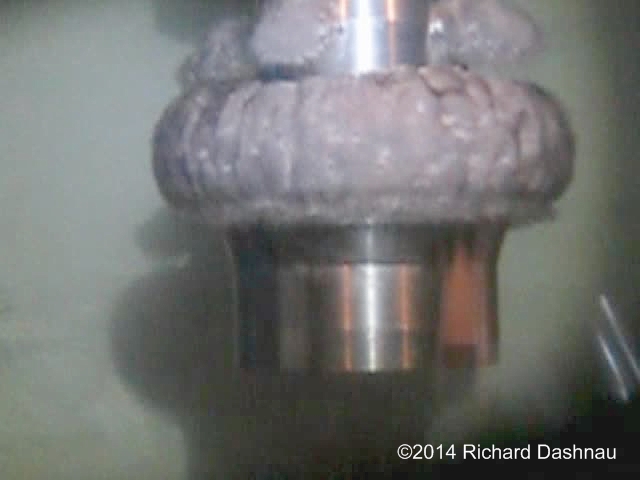
9/06/2012
-- Starting at
the end of August 2012, I started experimenting with various
animated gif images (anigifs), including images that might give
the illusion of 3 dimensions. I'm placing them here to
see how they look on a web page. The idea for the 2-image
"Wiggle 3D" gif is to take two photos of a subject with the camera
moved 4 inches or so (the distance between two eyes on a
human face) before taking the second photo. Alignment is the
important issue (and I'm still learning about that). I have an app
my Android phone that helps with this. It places cross hairs on
the view finder, and also shows a "phantom image" of the previous
photo. This makes alignment much easier between shots. If one
could see the two images side-by-side and blended together
at the same time, a 3D image should appear. Or, taking a series of
more aligned shots can give the illusion of 3 dimensions
since the subject rotates within frame. I've tried examples
of both
methods. After shooting the photos, I can use the program to view
the images flipping together and repeating, but the software does
NOT export a working video file or animated gif. I had to use
other software to make the animated gifs from the photos
(sometimes after some adjustment of the photos for brightness,
contrast, etc.) It would be a lot easier if the software capturing
the images
could also export them. Anyway, here they are.
Clicking on an image will show it larger.
Taken at the Houston
Museum of Natural Science:
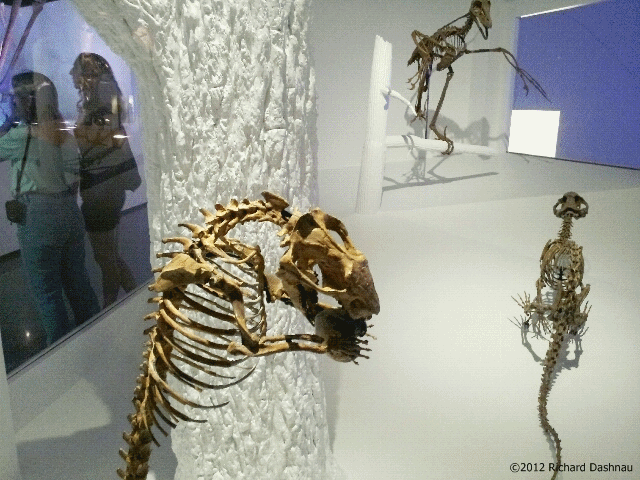 -
-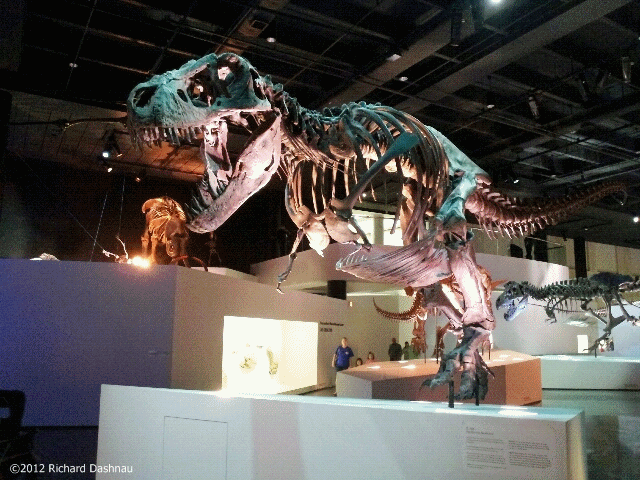 -
-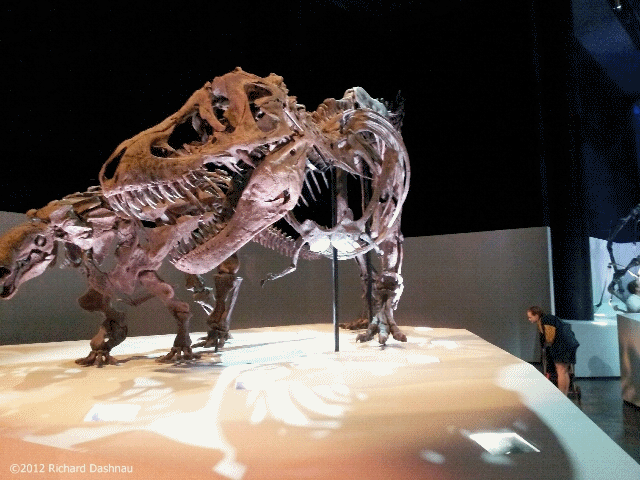 -
-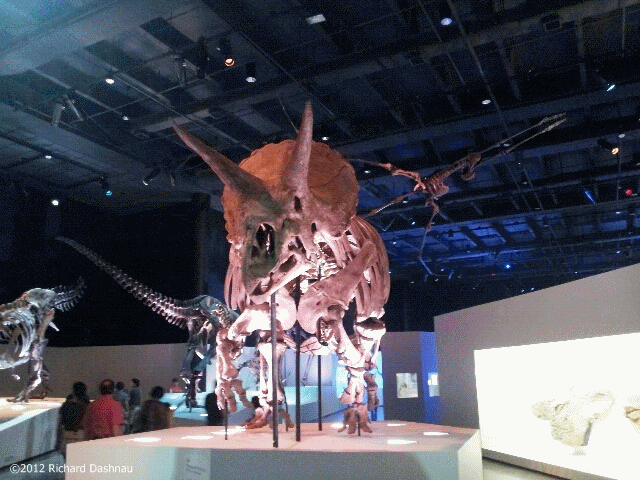 -
-
DIDELPHODON 09/23/12
TYRANNOSAURUS REX
"BUCKY" 09/23/12
TYRANNOSAURUS
REX "WYREX"09/23/12 TRICERATOPS
09/03/12
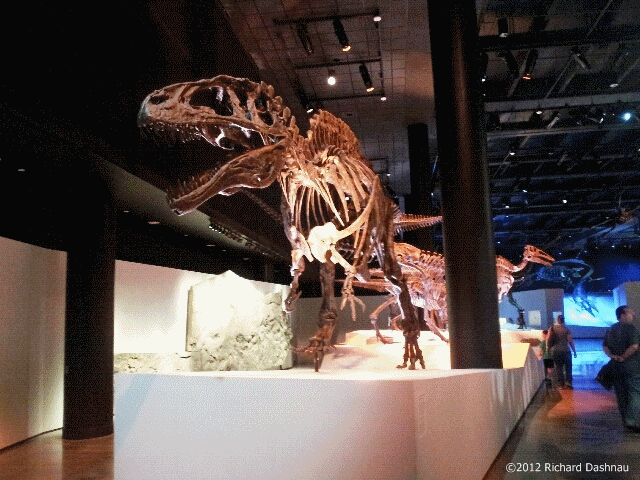 -
-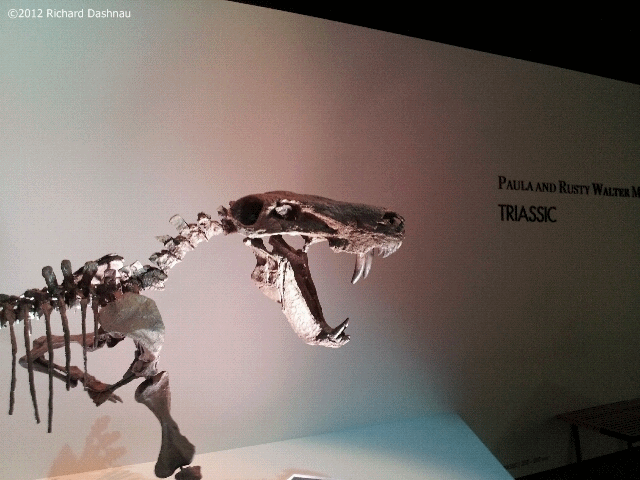 -
-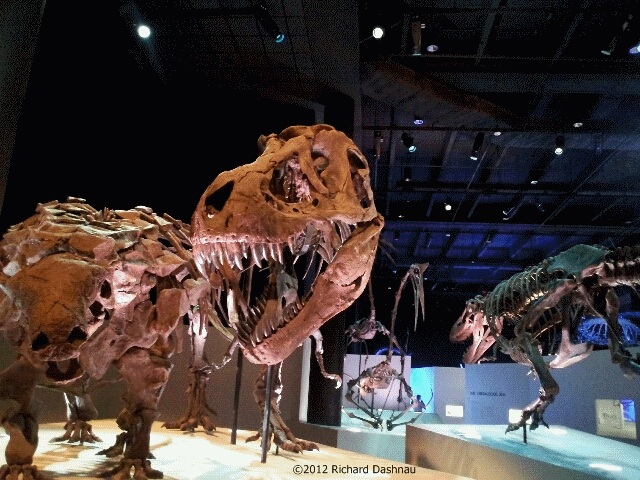 -
-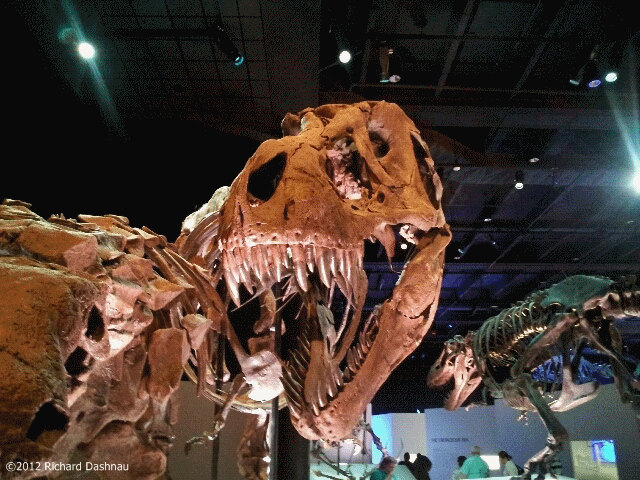 -
-
ACROCANTHOSAURUS
09/03/12
INOSTRANSEVIA 09/03/12
TYRANNOSAURUS
REX "WYREX" 08/26/12 TYRANNOSAURUS
REX "WYREX" 08/26/12
Various
subjects:
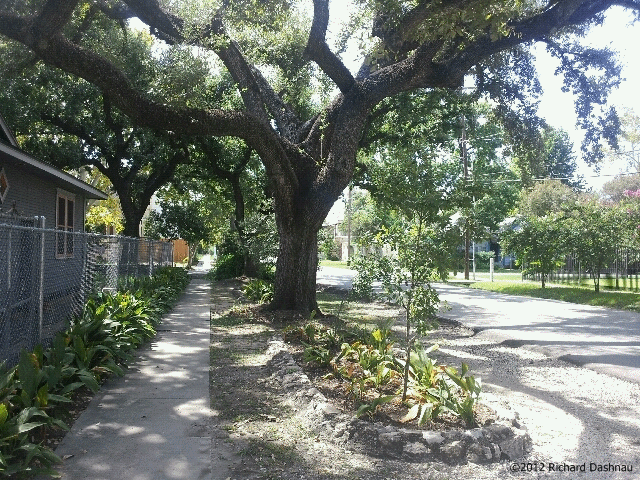 -
-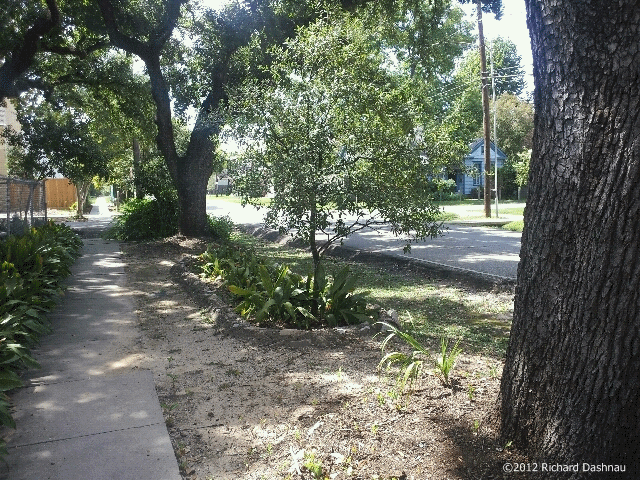
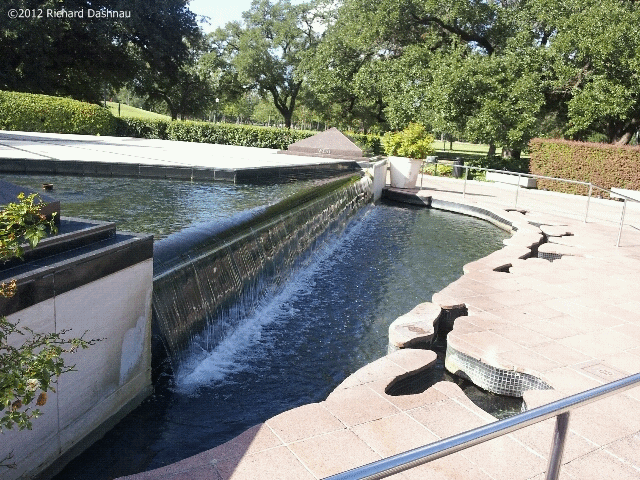
TREE IN THE HEIGHTS 09/05/12
TREE IN THE
HEIGHTS 09/05/12
FOUNTAIN 09/03/12
May
31, 2012-- DINOSAURS!!
The
Houston Museum of Natural Science (HMNS) has just opened their
upgraded Paleontology Hall. I was able to visit it a few days before
the public opening. What
a fantastic upgrade! I will post some pictures here, with a few
decscription, but that's it. If you are reading this, and you live in
Houston (or near it) then GO SEE IT! I've always been interested
in
dinosaurs and other prehistoric animals. From the time that I first
read about them as a child (back in the '60s) until now, the way that
dinosaurs and other ancient creatures are studied and
understood has changed very much. Advancements in analytical
technologies and the encorporating physics and mechanical analysis
(kinematics) to model the movements of extinct life forms from
studies of still extant animals can give clearer imagery of how they
may have lived. I'm sure it must be a wonderful, exciting time to be a
paleontologist! (Although...it was probably *always* exciting
to be a paleontologist.) So...these are some pictures of my
visit to HMNS and the new Paleontology Hall. These cannot convey
everything that is there. Entering the hall, we start early in
geologic
time. Among the things to see is a three-panel view into the ancient
ocean. But this isn't a painting--it's a moving display that appears
to be windows looking into the ancient ocean. The sun's rays
flex as they are bent by the surface above, and, as one watches, one
ancient creature oranother will appear out of the distance, or out of
the sandy bottom, move about, then move away. It's a
wonderful display--and you just have to go see it.
Eventually, one will encounter the Dimetrodon, a permian reptile--but
not a dinosaur. They haven't appeared yet. This creature was
cold-blooded. Dinosaurs were warm-blooded. A little further along,
after various other creatures, one encounters the Smilosuchus, a
crocodile-like animal. This was large, but not a true crocodile--those
appeared millions of yearslater. The Smilosuchus has nostrils
just in front of its eyes and living crocodilians don't. They
have nostrils at the end of their snout, with a passage that brings
air to openings in the throat behind their hard palate. I
counted, and the
Smilosuchus has 5 toes on all four feet. Alligators have 5 toes on
front feet, 4 toes on back feet. The display mentions an "armor " of
plates that cover the Smilosuchus--but the mounted specimen
doesn't show any.
--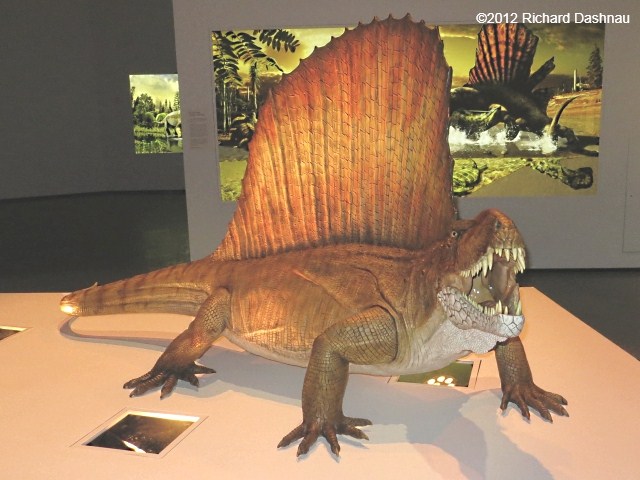 --
--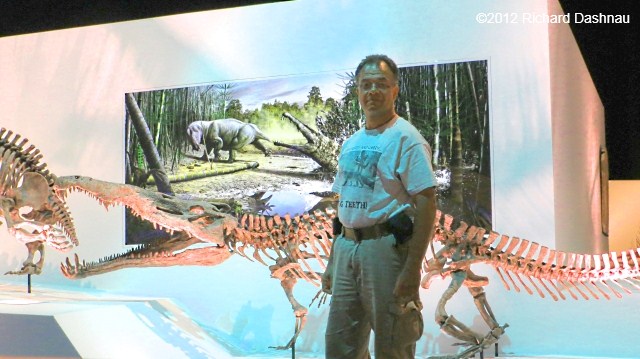 --
--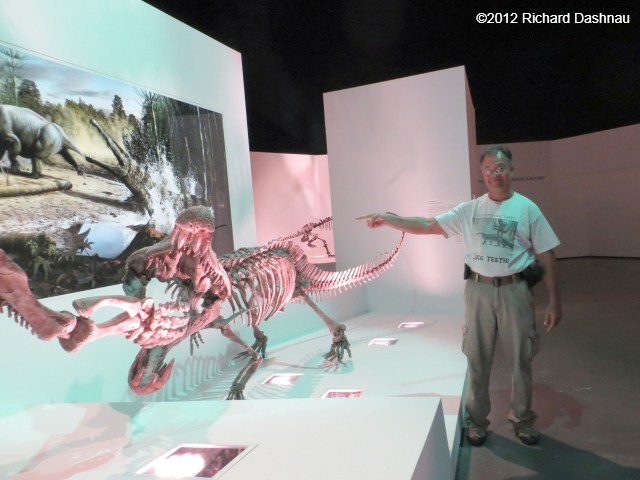 --
--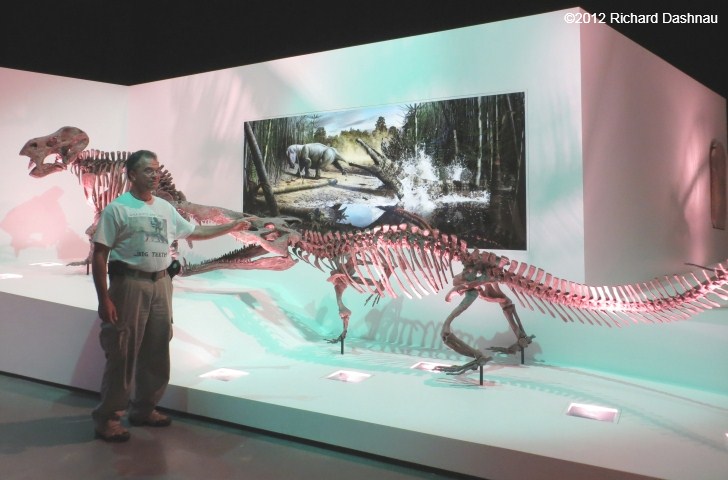
Closer views of the Smilosuchus skull show the nostrils
in front of the eyes. After some more interesting
displays, the Steneosaurus can be seen, mounted to the wall.
This was another
crocodile-like creature, but still not a true crocodilian. But it's
closer. I compared an alligator osteoderm to one that can
be seen on the fossil.
--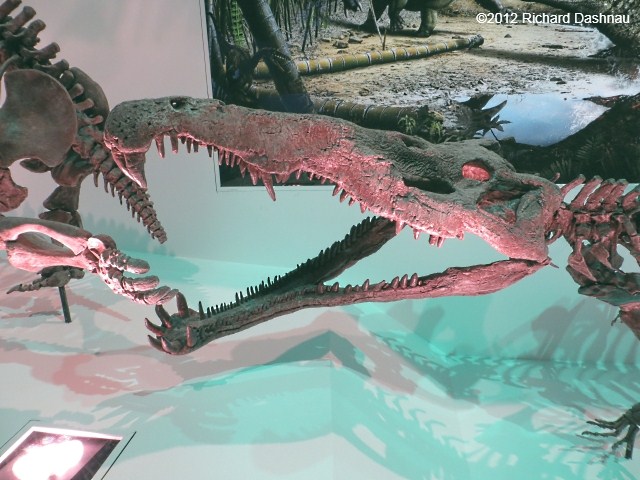 --
--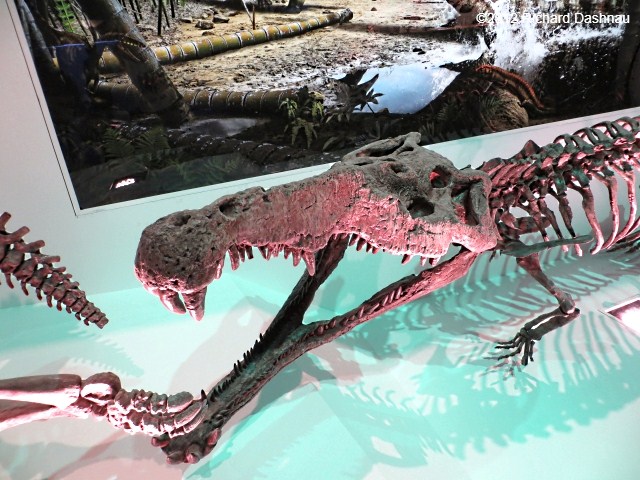 --
--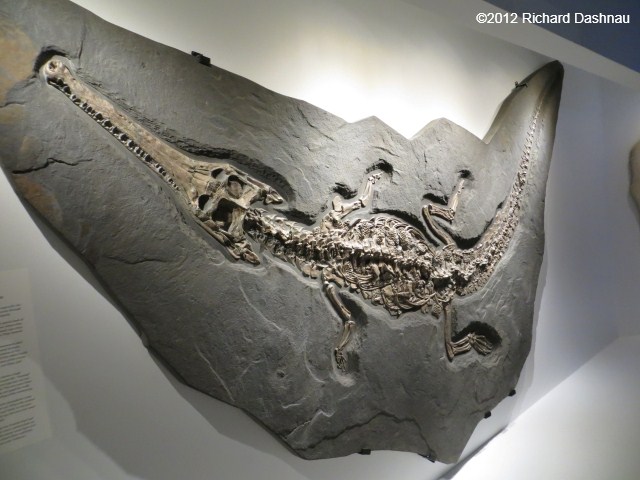 --
--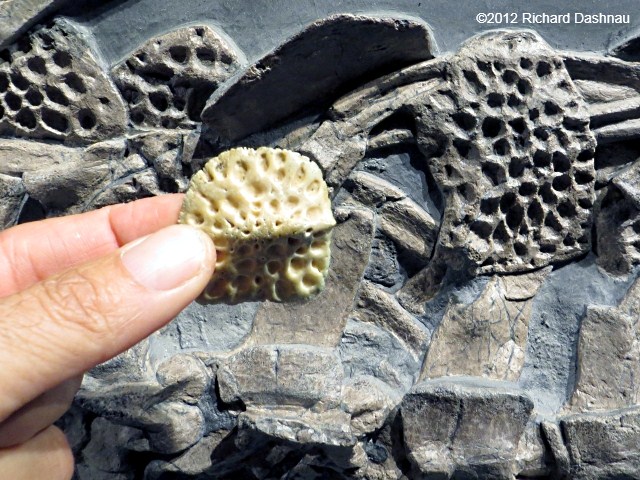
The
rear foot of the Steneosaurus has 4 toes, and the front foot has 5
toes.
Moving foreward will eventually bring one to the Late
Jurassic, and also to an Allosaurus. The Allosaurus is facing a
rearing Stegosaurus.
--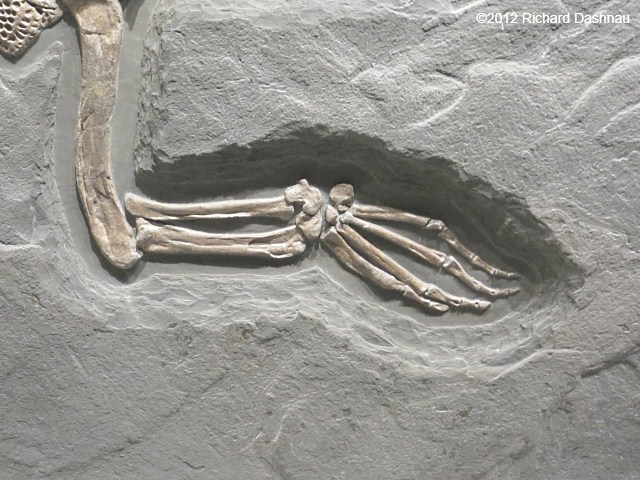 --
--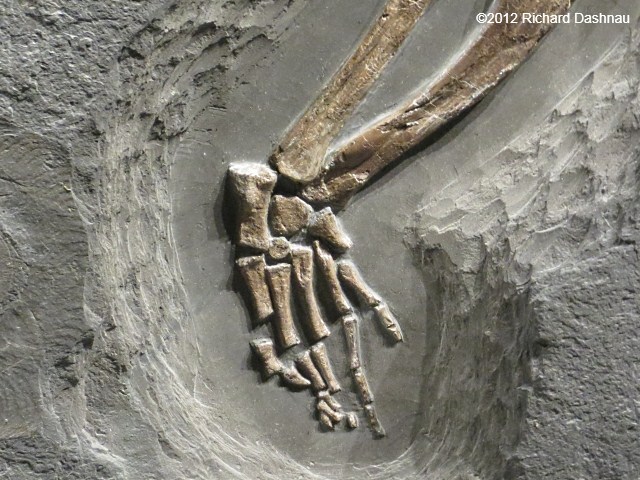 --
--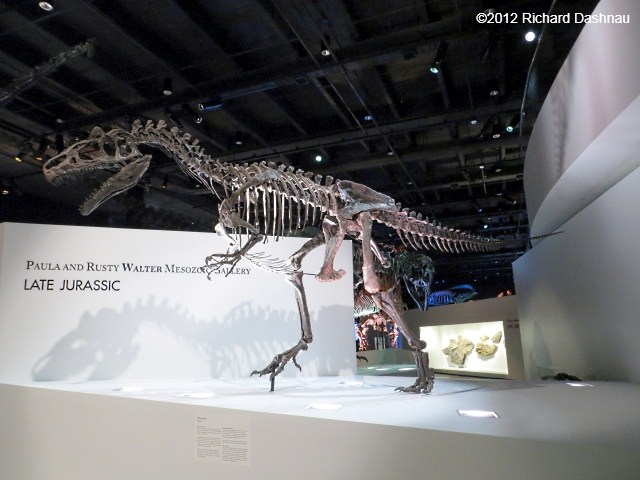 --
--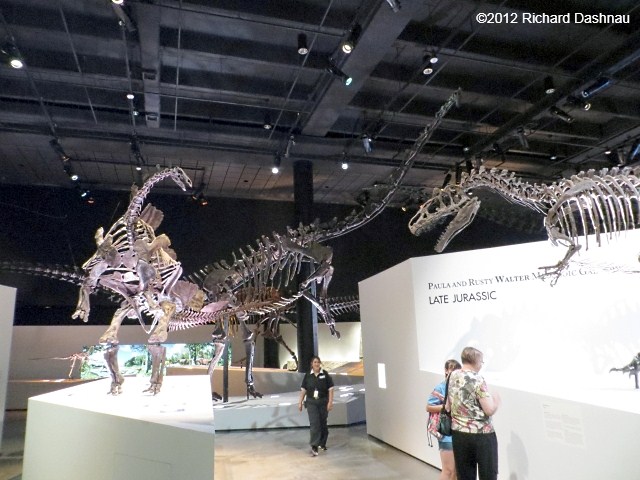
Passing under or around the Stegosaurus,
one then passes under a Diplodocus, and into what I call the "main
hall". And my first view of this just awed me. No use in describing
all of
the creatures on display. Look at the pictures below, and
then GO TO THE MUSEUM and see the display. It's impossible to show how
HUGE these are with pictures, and I'm not showing
video clips here. This is a herd of immense prehistoric
predators and herbivores, rearing, lunging and walking. GO
SEE THEM.
--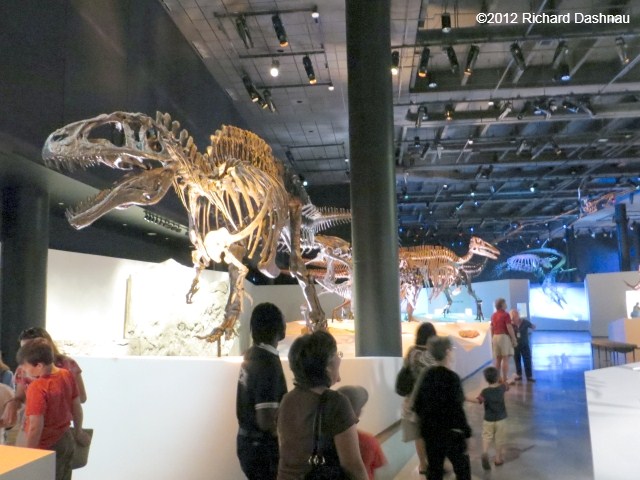 --
--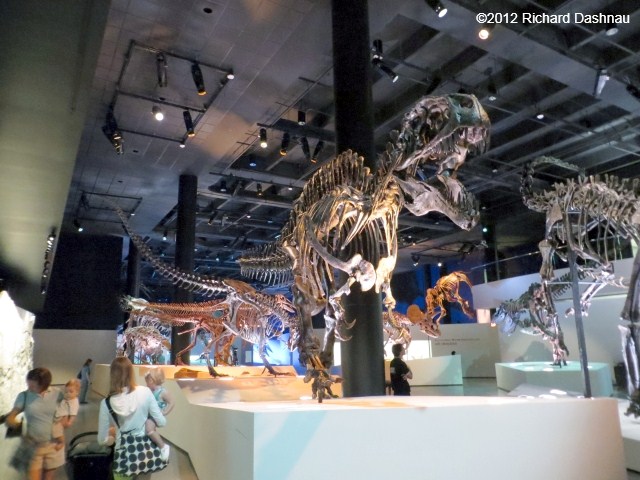 --
--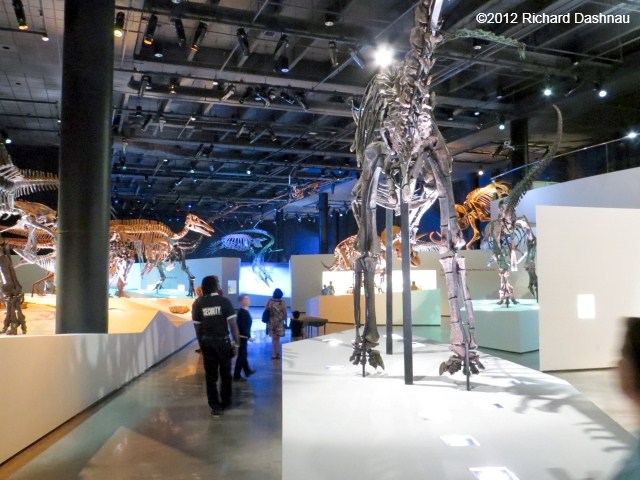 --
--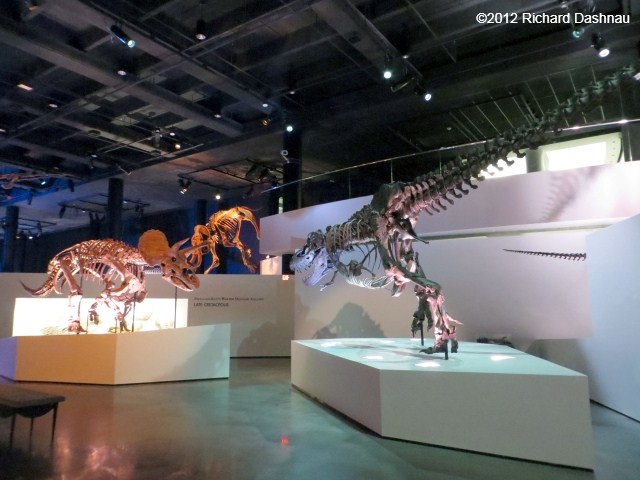
Near the back end of this section, there are a nesting
pair of Quetzalcoatlus--the largest-known flying creature...ever.
There's one mounted flying overhead (and I've seen this before),
but it's hard to tell the how big it really was. Unless,
one stands next to the nesting pair. Then, the effect is
something like imagining wings on...a giraffe. That's me standing next
to them.
Near them is a new Tyrannosaurus skeleton-a very
fine specimen. The description says that the end of the tail appears
to have been bitten off, with no healing evident. This could mean
that the tail was bitten off after the Tyrannosaurus
died--or just before it died. If the latter, I could imagine
that the Tyrannosaurus bled out and died after having its tail bitten
off (the
display mentions that the Tyrannosaurus would have had
difficulty walking without the tail to balance and without the muscle
attachments that were lost). On the other hand, if the
T.rex had fallen into a mud pit or drowned, or been
buried, then maybe only the tail was exposed--and this "cover"
was what preserved the body and the skeleton so well later.
--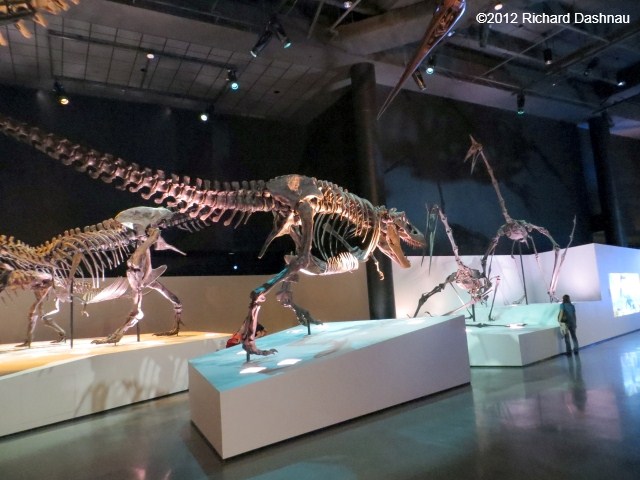 --
--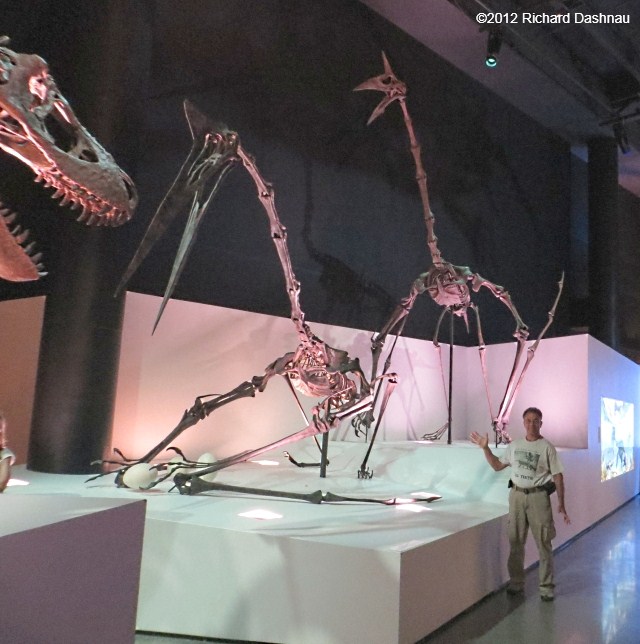 --
--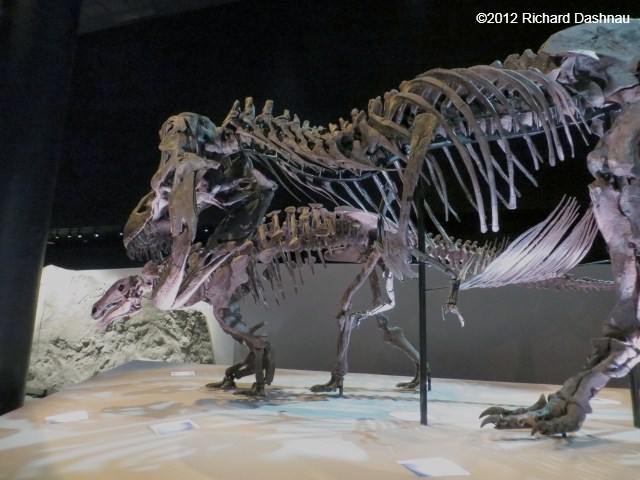 --
--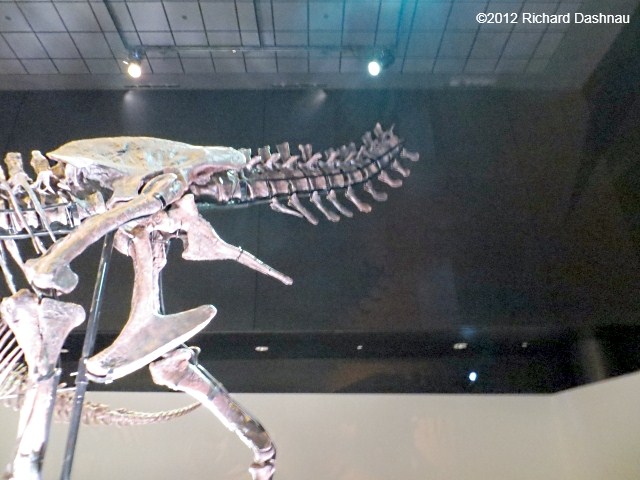
The forearms and front claws are also well-preserved, and
show an additional "toe" or spur that is not normally visible.
There are other specimens, and then one eventually will
come to this jaw of a Megalodon...a prehistoric shark.
--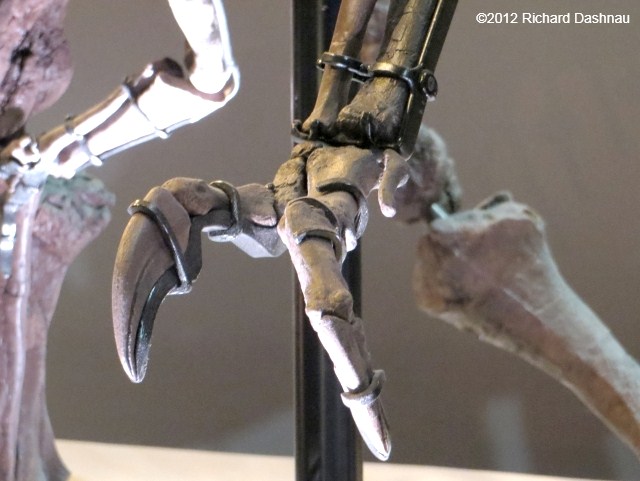 --
--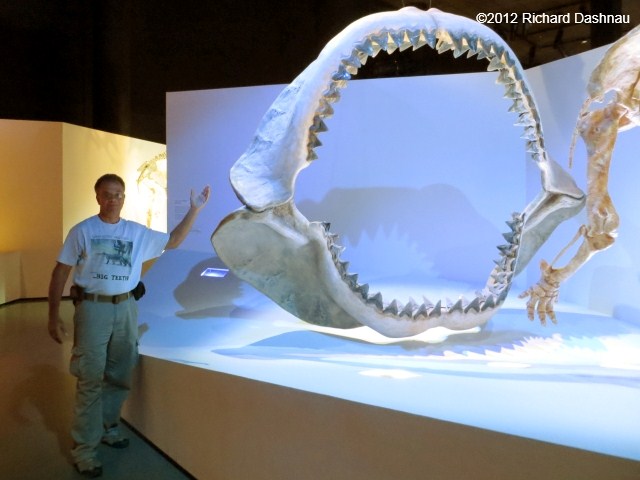 --
--
And that's a taste of
the new Paleontology Hall. I'll be going back again. Soon. Because
of my volunteer work at BBSP, I get to see, almost weekly, the
activities and habits of alligators--living
relatives of some of the
archosaurs at the museum. And--I get to see any number of about 300
species of birds that appear at BBSP--along with their activities and habits. And they are
related to
the dinosaurs at the museum.
June 04 & 18, 2005--
It was the weekend before my surgery (June 6th). I'd eaten at a nice
restaurant ("it NEVER closes") not far from downtown; and then I
went to get a haircut. I was driving
down Montrose when this house caught my attention. After my
haircut, I returned to the intersection of Montrose and
Willard, parked at the Texas Art Supply, walked across the
street, and took
the image shown in the OLD RICKUBISCAM, below.
-------------------------------------------
----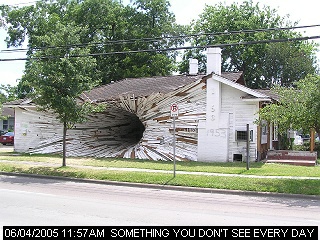
OLD
RICKUBISCAM
Now you know why I stopped. Below (TURN OFF THE
VACUUM!) is another picture from across the street.
Fortunately, I'd seen a short report on this on our local TV news
(but I hadn't noted
where the house was), or I wouldn't have known what to think when
I saw this. This house is an arresting sight when you don't expect
to see it.
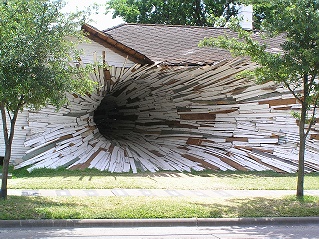 -
- -
-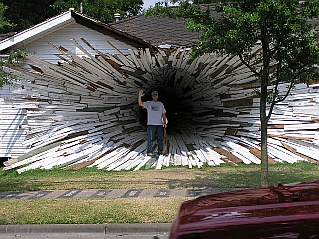 -
-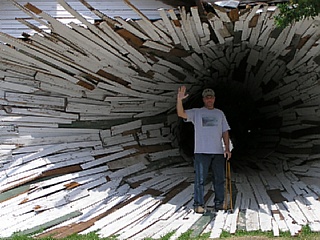 -
-
TURN OFf THE VACUUM!!
THE DESCRIPTION
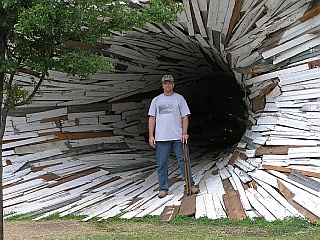
This house is actually an art piece. The card affixed
to it (see DESCRIPTION, above), named it as Inversion. I
was able to return to this house after my surgery, on June 18th.
The remaining
three images above show me inside the hole, showing scale. If you
happen to be in Houston, you might consider driving by and seeing
this for yourself. And,
I'm recovering quite well from
the surgery.
2003/2004/2005--
(added here 5/24/2022) Although I did put this material
on its own page, I thought I'd also link the page here, just for
the sake of history. So, here's the Fossil Crocs page.
This
page
was born 12/23/2010. Rickubis designed it. (such as it
is.) All contents �
2005-2022 Richard Dashnau
Go
back to my home page, Welcome
to Rickubis.com
Go back to the RICKUBISCAM









































































































